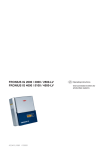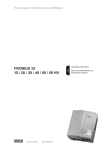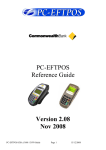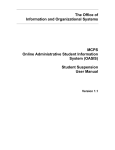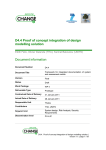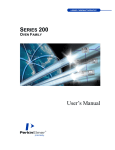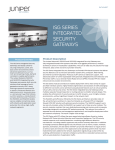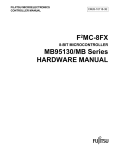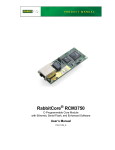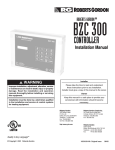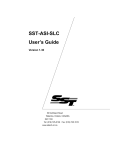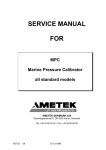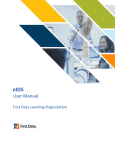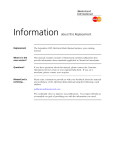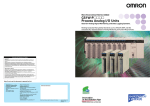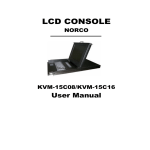Download TIP Guide, Entire Manual
Transcript
Return to Menu Information about this Replacement Replacement The November 2007 Terminal Integration Process Guide – EMV and PayPass replaces your existing document. What is in the New version? This new version introduces information relating to Maestro PayPass, and the clearing of ICC system-related data. It also provides updated information on the preparation phase and acquirer testing. Please refer to: • “Summary of Changes” for a comprehensive list of changes reflected in this update • “Using this Manual” for a complete list of the contents of this manual Questions? If you have questions about this manual, please contact the Customer Operations Services team or your regional help desk. Please refer to “Using this Manual” for more contact information. MasterCard is Listening… Please take a moment to provide us with your feedback about the material and usefulness of the Terminal Integration Process Guide – EMV and PayPass using the following e-mail address: [email protected] We continually strive to improve our publications. Your input will help us accomplish our goal of providing you with the information you need. Summary of Changes Terminal Integration Process Guide, November 2007 To locate these changes online—search on the date next to the revision bar. On the Adobe Reader toolbar, click Search. In the Search pane, type Nov 2007, and then click Search. Description of Change Where to Look Added information relating to Maestro PayPass. Chapter 1 Chapter 2 Chapter 4 Added information relating to clearing ICC system-related data. Chapter 1 Updated information relating to MasterCard network simulators. Chapter 1 Chapter 4 Appendix A Updated information relating to the actions the TIP team performs to validate the information you provide during the preparation phase. Chapter 3 Updated acquirer testing information. Chapter 4 1 of 1 Terminal Integration Process Guide EMV and PayPass November 2007 Proprietary Rights The information contained in this document is proprietary and confidential to MasterCard International Incorporated, one or more of its affiliated entities (collectively “MasterCard”), or both. This material may not be duplicated, published, or disclosed, in whole or in part, without the prior written permission of MasterCard. Trademarks Trademark notices and symbols used in this manual reflect the registration status of MasterCard trademarks in the United States. Please consult with the Customer Operations Services team or the MasterCard Law Department for the registration status of particular product, program, or service names outside the United States. All third-party product and service names are trademarks or registered trademarks of their respective owners. Media This document is available: • On MasterCard OnLine® • On the MasterCard Electronic Library (CD-ROM) MasterCard Worldwide 2200 MasterCard Boulevard O’Fallon MO 63368-7263 USA 1-636-722-6100 www.mastercard.com ©2007 MasterCard Terminal Integration Process Guide • November 2007 Publication Code: TIP Table of Contents Using this Manual Purpose ................................................................................................................... 1 Audience................................................................................................................. 1 Overview ................................................................................................................ 1 Notations................................................................................................................. 2 Excerpted Text ....................................................................................................... 2 Language Use ......................................................................................................... 3 Times Expressed..................................................................................................... 3 Revisions ................................................................................................................. 4 Related Information................................................................................................ 4 Support ................................................................................................................... 6 Member Relations Representative ................................................................... 7 Regional Representative................................................................................... 7 TIP Support ...................................................................................................... 7 Chapter 1 Overview What is the Terminal Integration Process? .........................................................1-1 Situating the TIP ..................................................................................................1-2 When to Perform a TIP?......................................................................................1-3 First or Additional TIP.........................................................................................1-4 First TIP .........................................................................................................1-4 Additional TIPs..............................................................................................1-4 Pre-requisites for TIP...........................................................................................1-5 Successful Completion of Network Interface Validation.............................1-5 Selection of an Approved Terminal .............................................................1-5 Terminal—Acquirer Host System Set-up......................................................1-6 Phases in the TIP Workflow ...............................................................................1-7 ©2007 MasterCard Terminal Integration Process Guide • November 2007 i Table of Contents Phase Phase Phase Phase Phase 1–Acquirer Preparation ......................................................................1-8 2–MasterCard Validation ....................................................................1-9 3–TIP Workshop.................................................................................1-9 4–Acquirer Testing ...........................................................................1-10 5–MasterCard Approval....................................................................1-12 Tools for TIP......................................................................................................1-12 ETEC (Easy TEst Cards) ..............................................................................1-12 Smartspy ......................................................................................................1-14 TcMonitor ....................................................................................................1-15 MasterCard Network Simulator...................................................................1-16 MasterCard Clearing Presentment Simulator - MCPS.................................1-17 Chapter 2 Acquirer Preparation Providing Information to MasterCard .................................................................2-1 TIP Information Form ...................................................................................2-1 Acquirer Implementation Conformance Statement......................................2-3 EMVCo Terminal Type Approvals................................................................2-5 PayPass Terminal Type Approvals...............................................................2-7 Terminal and Network Configuration Document ........................................2-7 Obtaining Relevant Version of ETEC Cards .......................................................2-8 Obtaining the Most Recent Version of the MasterCard Network Simulator .....2-8 Obtaining the Most Recent Version of the MCPS ..............................................2-8 Configuring the Terminal ....................................................................................2-9 Terminal Pre-requisites .................................................................................2-9 Configuring the Terminal............................................................................2-10 TIP Checklist......................................................................................................2-11 ii ©2007 MasterCard November 2007 • Terminal Integration Process Guide Table of Contents Chapter 3 MasterCard Validation Validation Steps ...................................................................................................3-1 Validation of Acquirer ICS ............................................................................3-2 Comparison of Acquirer ICS and Vendor ICS..............................................3-2 Selection of TIP Test Scenarios ....................................................................3-2 Creation of TIP Test Report Template .........................................................3-3 Creation of the TIP Test Procedure..............................................................3-3 Chapter 4 Acquirer Testing Introduction .........................................................................................................4-1 Understanding the TIP Test Scenarios................................................................4-2 Header—Scenario Identification Information ..............................................4-3 Body—Scenario Details ................................................................................4-3 Running the TIP Test Scenarios..........................................................................4-5 TIP Testing for the Authorization or Financial Messages............................4-6 TIP Testing for the Clearing Presentment Messages....................................4-7 Complete and Package the TIP Test Results................................................4-8 TIP Testing for the Authorization or Financial Messages ..................................4-9 Test Environment Setup with the MasterCard Network Simulator .............4-9 Deleting Previous MasterCard Authorization or MasterCard Debit Financial Simulator Logs .............................................................................4-10 Creating the MEAS Simulator Logs .............................................................4-11 Running the Transaction.............................................................................4-13 Importing the Card-Terminal Log to the PC ..............................................4-15 Saving the Card-Terminal Log ....................................................................4-18 Saving the MasterCard Authorization or MasterCard Debit Financial Simulator Logs.............................................................................................4-21 TIP Testing for the Clearing Presentment Messages........................................4-22 Setting up the Test Environment with the MCPS Simulator ......................4-22 Reset the Terminal Clearing Batch or Terminal Approved Transaction Log ...........................................................................................4-24 Reset the Clearing Batch on the Acquirer Host .........................................4-24 Running the Transaction.............................................................................4-24 Importing the Card-Terminal Log to the PC ..............................................4-25 Saving the Card-Terminal Log ....................................................................4-25 ©2007 MasterCard Terminal Integration Process Guide • November 2007 iii Table of Contents Download the Resulting Terminal Clearing Transactions and Generate the Corresponding IPM Clearing File.........................................4-25 Validate the IPM File Using the MCPS Simulator.......................................4-26 Extract and Save the MCPS Log..................................................................4-29 Complete and Package TIP Test Results ..........................................................4-30 Completing the TIP Test Report .................................................................4-30 Saving the TIP Test Report .........................................................................4-33 Sending TIP Test Report and Logs to the TIP Team .................................4-33 Avoiding Iterations ............................................................................................4-34 Chapter 5 MasterCard Approval Introduction .........................................................................................................5-1 TIP Test Report—Additional MasterCard Columns .....................................5-1 Iterations ..............................................................................................................5-2 TIP Letter of Approval.........................................................................................5-3 Appendix A Naming Conventions TIP INFO Filename ............................................................................................ A-1 TIP Acquirer ICS Filename................................................................................. A-1 Single Iteration ............................................................................................. A-2 Two Iterations .............................................................................................. A-4 TIP Test Report Filename................................................................................... A-6 Single Iteration ............................................................................................. A-6 Two Iterations .............................................................................................. A-8 Card-Terminal Log Filenames .......................................................................... A-10 MasterCard Authorization and MasterCard Debit Financial Simulator Log Filenames................................................................................................... A-11 MEAS Simulator Log Filenames ....................................................................... A-12 MCPS-CEE Simulator Log Filenames................................................................ A-13 iv ©2007 MasterCard November 2007 • Terminal Integration Process Guide Using this Manual This chapter contains information that helps you understand and use this document. Purpose ................................................................................................................... 1 Audience................................................................................................................. 1 Overview ................................................................................................................ 1 Notations................................................................................................................. 2 Excerpted Text ....................................................................................................... 2 Language Use ......................................................................................................... 3 Times Expressed..................................................................................................... 3 Revisions ................................................................................................................. 4 Related Information................................................................................................ 4 Support ................................................................................................................... 6 Member Relations Representative ................................................................... 7 Regional Representative................................................................................... 7 TIP Support ...................................................................................................... 7 ©2007 MasterCard Terminal Integration Process Guide • November 2007 i Using this Manual Purpose Purpose The MasterCard Terminal Integration Process Guide provides an overview of the various activities required when rolling out chip terminals supporting contact and contactless technology. Audience MasterCard provides this manual for members and their authorized agents. Specifically, the following personnel should find this manual useful: • Members of staff who will perform the Terminal Integration Process (TIP) testing • Program Managers and Project Managers for acquirers migrating to chip, (either contact, contactless, or both) • Member service providers working with acquirers migrating to chip, (either contact, contactless, or both) • Vendors who develop EMV-compliant terminals or PayPass™ compliant terminals Overview The following table provides an overview of this manual: Chapter Description Table of Contents A list of the manual’s chapters and subsections. Each entry references a chapter and page number. Using this Manual A description of the manual’s purpose and its contents. 1 Overview Provides an overview of the Terminal Integration Process (TIP) and places it in the context of the overall implementation process, for a chip terminal supporting EMV contact technology, PayPass contactless technology, or both. 2 Acquirer Preparation Describes the various actions that you must carry out to prepare for your TIP. 3 MasterCard Validation Describes the various actions that the TIP Team performs in order to validate the information you provided during the preparation phase. 4 Acquirer Testing Provides a step-by-step explanation of the various activities you perform during your TIP. 5 MasterCard Approval Describes how the TIP Consultant evaluates your TIP Test Report and, upon successful completion of all tests, generates the TIP Letter of Approval. ©2007 MasterCard Terminal Integration Process Guide • November 2007 1 Using this Manual Notations Chapter Description A Indicates the naming conventions to use during all exchanges related to your TIP. Naming Conventions Notations This document combines the description of TIP activities for contact and contactless interface terminals. Information specific to EMV terminals is indicated with the following symbol: Information specific to PayPass terminals is indicated with the following symbol: Information specific to dual interface terminals (supporting EMV and PayPass) is indicated with the following symbol: If you perform a TIP on a contact EMV terminal, you can skip the information and sections specific to contactless PayPass–M/Chip. If you perform a TIP on a PayPass terminal, you can skip the information specific to EMV terminals. If you perform a TIP on a dual interface terminal, you should read the whole document. Excerpted Text At times, this document may include text excerpted from another document. A note before the repeated text always identifies the source document. In such cases, we included the repeated text solely for the reader’s convenience. The original text in the source document always takes legal precedence. 2 ©2007 MasterCard November 2007 • Terminal Integration Process Guide Using this Manual Language Use Language Use The spelling of English words in this manual follows the convention used for U.S. English as defined in Merriam-Webster’s Collegiate Dictionary. MasterCard is incorporated in the United States and publishes in the United States. Therefore, this publication uses U.S. English spelling and grammar rules. An exception to the above spelling rule concerns the spelling of proper nouns. In this case, we use the local English spelling. Times Expressed MasterCard is a global company with locations in many time zones. The MasterCard operations and business centers are in the United States. The operations center is in St. Louis, Missouri, and the business center is in Purchase, New York. For operational purposes, MasterCard refers to time frames in this manual as either “St. Louis time” or “New York time.” Coordinated Universal Time (UTC) is the basis for measuring time throughout the world. You can use the following table to convert any time used in this manual into the correct time in another zone: Standard time St. Louis, Missouri USA Purchase, New York USA Central Time Eastern Time 09:00 10:00 15:00 09:00 10:00 14:00 UTC (first Sunday in November to second Sunday in March a) Daylight saving time (second Sunday in March to first Sunday in November b) a For Central European Time, last Sunday in October to last Sunday in March. b For Central European Time, last Sunday in March to last Sunday in October. ©2007 MasterCard Terminal Integration Process Guide • November 2007 3 Using this Manual Revisions Revisions MasterCard periodically will issue revisions to this document as we implement enhancements and changes, or as corrections are required. With each revision, we include a “Summary of Changes” describing how the text changed. Revision markers (vertical lines in the right margin) indicate where the text changed. The month and year of the revision appear at the right of each revision marker. Occasionally, we may publish revisions or additions to this document in a Global Operations Bulletin or other bulletin. Revisions announced in another publication, such as a bulletin, are effective as of the date indicated in that publication, regardless of when the changes are published in this manual. Related Information The following documents relate to this manual: • MasterCard Credit Authorization Simulator • MasterCard Debit Financial Simulator • MasterCard European Authorization Simulator Guide • MasterCard Clearing Presentment Simulator Guide For Contact Chip • M/Chip Functional Architecture for Debit and Credit • ETEC User Guide • Smartspy User Guide For Contactless Chip 4 • PayPass–M/Chip, Acquirer Implementation Requirements • Maestro PayPass – Acquirer Implementation Requirements • TIP User Guide for MasterCard PayPass Test Cards ETEC Subset 6 • TIP User Guide for MasterCard PayPass Test Cards ETEC Subset 8 • TIP User Guide for Maestro PayPass ETEC Subset ©2007 MasterCard November 2007 • Terminal Integration Process Guide Nov 2007 Using this Manual Related Information For definitions of key terms used in this document, please refer to the MasterCard Dictionary on the Member Publications home page (on MasterCard OnLine® and the MasterCard Electronic Library CD-ROM). To order MasterCard manuals, please use the Ordering Publications service on MasterCard OnLine®, or contact the Customer Operations Services team. To order PayPass manuals, please use the ordering publication service on www.paypass.com or contact [email protected] TIP User Manuals are provided together with the ETEC test cards when purchased. ©2007 MasterCard Terminal Integration Process Guide • November 2007 5 Using this Manual Support Support Please address your questions to the Customer Operations Services team as follows: Phone: 1-800-999-0363 or 1-636-722-6176 1-636-722-6292 (Spanish language support) Fax: 1-636-722-7192 E-mail: Canada, Caribbean, Latin America, South Asia/Middle East/Africa, and U.S. [email protected] Asia/Pacific: 6 Australia and New Zealand [email protected] China, Hong Kong, and Taiwan [email protected] South East Asia [email protected] Japan/Guam [email protected] Korea [email protected] Europe [email protected] Spanish language support [email protected] Vendor Relations, all regions [email protected] Address: MasterCard Worldwide Customer Operations Services 2200 MasterCard Boulevard O’Fallon MO 63368-7263 USA Telex: 434800 answerback: 434800 ITAC UI ©2007 MasterCard November 2007 • Terminal Integration Process Guide Using this Manual Support Member Relations Representative Member Relations representatives assist U.S. members with marketing inquiries. They interpret member requests and requirements, analyze them, and if approved, monitor their progress through the various MasterCard departments. This does not cover support for day-to-day operational problems, which the Customer Operations Services team addresses. For the name of your U.S. Member Relations representative, contact your local Member Relations office: Atlanta Chicago Purchase San Francisco 1-678-459-9000 1-847-375-4000 1-914-249-2000 1-925-866-7700 Regional Representative The regional representatives work out of the regional offices. Their role is to serve as intermediaries between the members and other departments in MasterCard. Members can inquire and receive responses in their own languages and during their offices’ hours of operation. For the name of the location of the regional office serving your area, call the Customer Operations Services team at: Phone: 1-800-999-0363 or 1-636-722-6176 1-636-722-6292 (Spanish language support) TIP Support Please address your questions regarding the TIP to the one of the following email addresses: Region E-mail address Europe [email protected] Asia Pacific [email protected] South Asia, Middle East, and Africa [email protected] North America [email protected] Latin America and Caribbean [email protected] ©2007 MasterCard Terminal Integration Process Guide • November 2007 7 1 Overview This chapter provides an overview of the Terminal Integration Process (TIP) and places it in the context of the overall implementation process, for a chip terminal supporting EMV contact technology, PayPass contactless technology, or both. What is the Terminal Integration Process? .........................................................1-1 Situating the TIP ..................................................................................................1-2 When to Perform a TIP?......................................................................................1-3 First or Additional TIP.........................................................................................1-4 First TIP .........................................................................................................1-4 Additional TIPs..............................................................................................1-4 Pre-requisites for TIP...........................................................................................1-5 Successful Completion of Network Interface Validation.............................1-5 Selection of an Approved Terminal .............................................................1-5 EMV Terminals (contact interface).........................................................1-5 PayPass Terminals (contactless interface) .............................................1-6 Dual Interface Terminals ........................................................................1-6 Terminal—Acquirer Host System Set-up......................................................1-6 Phases in the TIP Workflow ...............................................................................1-7 Phase 1–Acquirer Preparation ......................................................................1-8 Phase 2–MasterCard Validation ....................................................................1-9 Phase 3–TIP Workshop.................................................................................1-9 TIP Workshop Objectives.......................................................................1-9 Phase 4–Acquirer Testing ...........................................................................1-10 Phase 4a – TIP Testing for the Authorization or Financial Messages................................................................................1-10 Phase 4b – TIP Testing for the Clearing Presentment Messages ........1-11 Phase 4c - Complete and Package TIP Test Results............................1-11 Iterations................................................................................................1-11 Phase 5–MasterCard Approval....................................................................1-12 Tools for TIP......................................................................................................1-12 ETEC (Easy TEst Cards) ..............................................................................1-12 EMV Terminal .......................................................................................1-12 PayPass–M/Chip Terminal....................................................................1-13 ©2007 MasterCard Terminal Integration Process Guide • November 2007 1-i Overview Dual Interface Terminal........................................................................1-13 Smartspy ......................................................................................................1-14 TcMonitor ....................................................................................................1-15 MasterCard Network Simulator...................................................................1-16 Choice of MasterCard Network Simulator(s) .......................................1-16 Benefits of MasterCard Network Simulators ........................................1-16 Updating MasterCard Network Simulators...........................................1-16 MasterCard Clearing Presentment Simulator - MCPS.................................1-17 Purpose .................................................................................................1-17 Updating the MCPS...............................................................................1-17 1-ii ©2007 MasterCard November 2007 • Terminal Integration Process Guide Overview What is the Terminal Integration Process? What is the Terminal Integration Process? The Terminal Integration Process (TIP) is a key testing phase, designed to test the terminal, intermediate connections, and the interface with the acquirer host system, in conditions that are as close as possible to its final environment of use. This includes the complete connection path from your terminal to either: • The MasterCard Debit Switch (MDS) system if you are using the MDS single message format, or • The Banknet, RSC/APC, or EPS-Net MasterCard network systems using the CIS, AS2805, or V5 authorization format and to the Global Clearing Management System (GCMS) using the IPM clearing message format. The interface to GCMS shall only be tested if you are sending DE 55-ICC system related data, in clearing presentment messages. 1 The TIP applies to EMV, PayPass–M/Chip, and dual interface terminals. A dual interface terminal supports both EMV (contact technology) and PayPass (contactless technology) in one terminal. In this case, PayPass contactless technology is either embedded in the terminal or resides in an external card reader attached to the terminal. The objectives of the TIP are to: • Ensure that your terminal meets MasterCard brand requirements, as specified in Table 1.1: Table 1.1—MasterCard Brand Requirements Symbol Requirement M/Chip Functional Architecture for Debit and Credit available on MasterCard OnLine PayPass–M/Chip Acquirer Implementation Requirements available on www.paypass.com and Maestro PayPass – Acquirer Implementation Requirements 2 1 MasterCard and Maestro Europe region acquirers must supply the correct chip data in their first presentment messages for intra-European chip transactions as of April 1 2007, as described in the European Operation Bulletin No. 1 dated 3 January 2006. 2 The Maestro PayPass – Acquirer Implementation Requirements document can be obtained by sending an email to [email protected] ©2007 MasterCard Terminal Integration Process Guide • November 2007 1-1 Nov 2007 Overview Situating the TIP If the terminal does not support Maestro PayPass, it must only support the requirements specified in the M/Chip Functional Architecture for Debit and Credit and the PayPass – M/Chip Acquirer Implementation Requirements. • Ensure that your terminal and in particular its EMVCo approved kernel and/or PayPass application, meets your business needs • Test your terminal’s capabilities in terms of interoperability, and detect issues at an early stage, thus saving you both time and money Situating the TIP To make the adoption of chip terminals as simple as possible, MasterCard has designed a step-by-step implementation process to facilitate migration of your terminals to chip. The TIP is one of the terminal-related services available. Figure 1.1 illustrates where the TIP fits into an acquirer chip migration process. Figure 1.1—TIP within Acquirer Chip Migration Process Network Interface Validation Terminal Integration Process Production Set-up End-to-End Demonstration Key Management 1-2 ©2007 MasterCard November 2007 • Terminal Integration Process Guide Nov 2007 Overview When to Perform a TIP? When to Perform a TIP? The TIP must be performed when a new terminal is selected for deployment. An existing terminal that has TIP approval but is upgraded must also be submitted for TIP if the upgrades are major. If an approved version of the terminal application is modified, please inform the TIP Team. The TIP Team will advise on whether a full or partial TIP must be performed based on the reported modifications. Examples of major changes are: • Existing and approved EMV terminal which is upgraded with a new EMV kernel version (must be submitted for TIP of an EMV contact interface terminal) • Existing EMV terminal with TIP approval is upgraded to include PayPass– M/Chip (must be submitted for TIP of a dual interface terminal) • Existing PayPass–M/Chip terminal with TIP approval is upgraded to include EMV (must be submitted for TIP of a dual interface terminal) • Existing and approved PayPass–Mag Stripe terminal is upgraded to include EMV and/or PayPass–M/Chip (must be submitted for TIP of a dual interface terminal) If you are clearing the ICC system-related data in the presentment messages, the TIP testing for the Clearing Presentment messages must be performed for every new terminal type (either Attended POS, Unattended POS, Bank Branch Terminal, or ATM) you are implementing. If you are clearing the ICC system-related data in the presentment messages and implementing additional terminals of a same type, the TIP testing for Clearing Presentment messages is optional. Note A PayPass–M/Chip terminal also supports PayPass–Mag Stripe. During TIP of a PayPass–M/Chip or dual interface terminal, PayPass–Mag Stripe requirements are tested. However, there is no TIP for PayPass–Mag Stripe terminals. ©2007 MasterCard Terminal Integration Process Guide • November 2007 1-3 Nov 2007 Overview First or Additional TIP First or Additional TIP The following two sections describe: • First TIP • Additional TIPs First TIP A first TIP is always part of a chip implementation project. The project’s Chip Implementation Plan includes the activities related to this First TIP. A MasterCard Regional Customer Representative is appointed to support you during your implementation project.. Once you have signed off the Chip Implementation Plan, the MasterCard representative contacts the various teams—including the TIP team—to request testing slots. For a first TIP, MasterCard provides a two-day workshop. You must perform one first TIP per terminal type (POS and ATM) per application (EMV or PayPass–M/Chip.) Additional TIPs Once you have completed your first TIP, you may contact the TIP team directly for all subsequent projects (using the TIP mailbox relevant for your region, as indicated in ‘Using this Manual’). For additional TIPs, a workshop is not included unless specifically requested by the acquirer. Additional TIPs are managed by a TIP Consultant. 1-4 ©2007 MasterCard November 2007 • Terminal Integration Process Guide Overview Pre-requisites for TIP Pre-requisites for TIP The following sections describe the pre-requisites for TIP: • Successful completion of Network Interface Validation • Selection of an approved terminal • Terminal-acquirer host system set-up Successful Completion of Network Interface Validation Before starting the TIP, you must have successfully completed Network Interface Validation testing, as shown in Figure 1.1. Selection of an Approved Terminal You must ensure that you select a terminal that: • Thoroughly meets your business needs • Passed the required tests and the vendor obtained the required letters of approval, as listed in the following sections During the TIP, the TIP Consultant examines the terminal capabilities you have selected and communicate the findings to you. EMV Terminals (contact interface) For EMV Terminals, you should ensure that they have: • Passed EMVCo Terminal Type Approval Level 1 • Passed EMVCo Terminal Type Approval Level 2 • Obtained the TQM Label (or the vendor must have started the Terminal Quality Management process and provide the reference of the TQM Action Plan) If you have not selected your EMV Terminal yet, MasterCard recommends that you select a terminal from the M/Chip Approved Products list, in the Smart Card category of Member Publications on MasterCard OnLine. ©2007 MasterCard Terminal Integration Process Guide • November 2007 1-5 Overview Pre-requisites for TIP PayPass Terminals (contactless interface) For PayPass Terminals, you should ensure that they have the PayPass Letters of Approval. If you have not selected your PayPass Terminal yet, MasterCard recommends that you select a terminal or card reader from the PayPass Approved Products list on www.paypass.com Dual Interface Terminals For dual interface terminals, you should ensure they have the pre-requisites for both EMV and PayPass Terminals, as listed above. Also ensure that the approvals apply to the actual terminal with both the contact and contactless interfaces included. For example, adding the contactless interface to an approved EMV Terminal may impact the application kernel in such a way that the existing EMVCo approval is no longer valid. This terminal needs a re-approval for the updated kernel by EMVCo. Terminal—Acquirer Host System Set-up You must ensure that the terminal, all intermediate connections, and its interfaces (including the clearing interface), together with the Acquirer Host System (AHS)—also referred to as the ‘Authorization System’—are set up according to your own functional requirements and have been thoroughly tested before starting the TIP. This includes the single or dual message interfaces to the MasterCard network systems: Connection Type Message Types Dual Authorization / clearing message connection 0100 / 0110 Authorization messages Single message connection 1-6 Message Format Specifications • Customer Interface Specification (CIS) message format • AS 2805 message format • V5 interface specification 1240 - Clearing presentment message • IPM clearing format 0200 /0210 - Financial messages • MDS message format ©2007 MasterCard November 2007 • Terminal Integration Process Guide Overview Phases in the TIP Workflow Phases in the TIP Workflow Figure 1.2 provides an overview of the four main phases of the TIP workflow. Figure 1.2—TIP Workflow Preparation (Acquirer) Validation (MasterCard) Send Documents to TIP Team Not OK Validate Acquirer ICS against Acquirer ICS MasterCard Validation Results Requirements Perform Tests Send Completed TIP Test Report & Logs Not OK Approval (MasterCard) Acquirer ICS OK Terminal & Network Configuration Letter(s) of Approval and Vendor ICS Compare Acquirer ICS and ICS Letter(s) of Comparison Approval Results Summary Generate TIP Test Report template Testing (Acquirer) TIP Information Form Summary Select TIP Scenarios TIP Test Report template TIP Test Procedure Analyze Results TIP Test Report Card – Terminal Logs (1 per test) Simulator Log (1 per test) MCPS Log (1 log for all clearing tests) Analyze TIP Test Report(s) & Logs OK TIP Letter of Approval Final TIP Test Report ©2007 MasterCard Terminal Integration Process Guide • November 2007 1-7 Overview Phases in the TIP Workflow The TIP workflow consists of five phases, as shown in Table 1.2. Phase 3 (TIP Workshop) only applies to First TIPs and is not considered, in the context of this manual, as a main phase of the TIP workflow. Table 1.2—Phases of the TIP Workflow Phase Name 1 Acquirer Preparation 2 MasterCard Validation 3 TIP Workshop 4 Acquirer Testing 5 MasterCard Approval A brief description of each phase is provided in the following sections. Detailed explanations are provided in subsequent chapters. Phase 1–Acquirer Preparation When you are ready to start a TIP, you contact the TIP Team. The TIP Team provides all the necessary documentation and forms for the project. All forms must be completed and sent to the appropriate TIP mailbox together with the required terminal approval statements. This includes the: • TIP Information Form: A form requiring your contact details and terminal information. • Acquirer Implementation Conformance Statement (ICS): A form requiring your bank’s functional requirements, such as applications supported, terminal type, online/offline capabilities, etc. • Terminal and Network Configuration Document: A form requiring an overview of your acquirer acceptance environment and various intermediate connections between the terminal and the MasterCard network. • Terminal Approval Statements: Documentation from your vendor to MasterCard with proof of EMVCo and/or PayPass terminal approval (Letter of Approval) and technical details (Vendor ICS) of the selected terminal. Chapter 2 provides detailed explanations of this phase. 1-8 ©2007 MasterCard November 2007 • Terminal Integration Process Guide Overview Phases in the TIP Workflow Phase 2–MasterCard Validation Upon receipt of the correctly completed documents, the TIP Consultant: • Ensures that the responses given in your Acquirer ICS are in line with MasterCard requirements. You will receive an Acquirer ICS Validation Results Summary, indicating the results of the analysis. • Compares your Acquirer ICS with the Terminal Approval Statements to ensure that they are compatible. You will receive an ICS Comparison Results Summary, indicating the results of the analysis. • Selects the test scenarios specific to your terminal profile. • Sends the TIP Test Scenarios you need to perform, and the TIP Test Report Template you need to complete to provide the results of the tests. Chapter 3 provides detailed explanations of this phase. Phase 3–TIP Workshop If this is your First TIP, a TIP Consultant comes on site to run a two-day workshop. This workshop explains the TIP, and trains your staff that will actually perform the TIP. If you are carrying out an Additional TIP, there is no TIP Workshop, unless specifically requested. TIP Workshop Objectives The objectives of the workshop are to: 1. Provide a general overview of the TIP. This part of the workshop is a general presentation of the TIP. It may be of interest to management, as well as to the staff that will perform the TIP. 2. Give hands-on technical training. The technical training consists of: • Verification of the terminal configuration ©2007 MasterCard Terminal Integration Process Guide • November 2007 1-9 Overview Phases in the TIP Workflow • Setting up of the application to save and analyze the dialogue between card and terminal and explanations on how to use this application for: − An EMV terminal: The Smartspy − A PayPass terminal: The TcMonitor • Explanations on how to use the ETEC cards • Verification of the MasterCard network simulator configuration • Explanations on how to save the MasterCard network simulator and card-terminal logs • Explanations on how to use the MCPS simulator to validate the chip data in the clearing presentment messages and save the related MCPS validation logs • Explanations on how to interpret the test results • Explanations on how to complete the TIP Test Report For the technical training part of the workshop, we recommend that the participants are only those individuals who will be carrying out the actual TIP testing and complete the ETEC Test Report. 3. Demonstrate how to run a test. If required, the TIP Workshop can also be used to help you complete the Acquirer ICS. Phase 4–Acquirer Testing Once you have completed the necessary questionnaires and supplied the appropriate reference information to the TIP team and receive the TIP test scenarios, you are ready to test your terminal. Phase 4a – TIP Testing for the Authorization or Financial Messages For the testing of your terminal with the 0100/0110 Authorization messages or 0200/0210 Financial messages, you must: 1. Run the tests. 2. Save the MasterCard network simulator logs and card-terminal logs (either Smartspy log or ATM card/terminal log). 1-10 ©2007 MasterCard November 2007 • Terminal Integration Process Guide Overview Phases in the TIP Workflow Phase 4b – TIP Testing for the Clearing Presentment Messages As required, to test your terminal for the clearing presentment messages, you must: 1. Reset the terminal clearing batch or terminal approved transaction log. 2. Reset the clearing batch on the acquirer host. 3. Run the clearing tests while saving the corresponding card-terminal logs. 4. Download the resulting terminal clearing transactions to your acquirer host and generate the corresponding IPM clearing file. 5. Validate the IPM file using the MCPS-CEE module (MasterCard Clearing Presentment Simulator – Clearing Emulation Engine). 6. Extract and save the MCPS-CEE log. Phase 4c - Complete and Package TIP Test Results Once the TIP testing is complete, you must: 1. Complete the TIP Test Report. 2. Send the TIP Test Report, card-terminal logs, the MasterCard network simulator logs and the MCPS log to the appropriate mailbox (refer to the ‘TIP Support’ section of the ‘Using this Manual’ chapter). The TIP team reviews your TIP Test Report, card-terminal logs, MasterCard network and MCPS-CEE simulator logs, and decides if your terminal has satisfactorily passed all tests. Iterations If the test results are inconclusive, the TIP Consultant indicates this in the TIP Test Report, which is sent back to you for action. You should remedy the problem, perform the required re-testing, and submit the results to the TIP team. This process is referred to as an ‘iteration’. See Chapter 5 for more information about iterations. Chapter 4 provides detailed explanations of this phase. ©2007 MasterCard Terminal Integration Process Guide • November 2007 1-11 Overview Tools for TIP Phase 5–MasterCard Approval Once you have successfully completed all tests, you send the test results to the TIP Team. The results are validated and if all tests were completed successfully, the TIP Team sends you the following documents: • Final TIP Test Report indicating the results of the tests • TIP Letter of Approval (LoA) applicable to the type of terminal that was tested Chapter 5 provides detailed explanations of this phase. Tools for TIP A number of tools are available to facilitate the TIP. They are summarized in the following sections. Details on how to order these tools are provided in Chapter 2. ETEC (Easy TEst Cards) MasterCard has designed sets of test cards, known as the ETEC cards, to allow you to test your host and terminal payment applications’ compliance with MasterCard requirements, as defined in the M/Chip Functional Architecture for Debit and Credit, PayPass–M/Chip Acquirer Implementation Requirements, and Maestro PayPass – Acquirer Implementation Requirements. The ETEC cards are grouped into different ‘subsets’ to allow targeted testing. For the TIP, the following subsets are used: EMV Terminal The following subsets are used for an EMV terminal: • ETEC Subset 1—designed to test acceptance of MasterCard branded cards in a cross-border transactions context • ETEC Field Interoperability Subset—designed to reproduce specific interoperability issues that have occurred in the field. They allow you to ensure that your terminal can handle acceptance correctly to avoid these issues in the field 1-12 ©2007 MasterCard November 2007 • Terminal Integration Process Guide Nov 2007 Overview Tools for TIP PayPass–M/Chip Terminal The following subsets are used for a PayPass–M/Chip Terminal: • PayPass–M/Chip ETEC subset 8: designed to ensure that the terminal is able to manage the PayPass technology according to MasterCard requirements for PayPass–M/Chip • PayPass–Mag Stripe ETEC subset 6: designed to ensure that the terminal is able to manage the PayPass technology according to MasterCard requirements for PayPass–Mag Stripe. A TIP for a PayPass–M/Chip terminal also includes the testing of PayPass–Mag Stripe transactions. • Maestro PayPass ETEC subset: designed to ensure that the terminal is able to manage the PayPass technology according to MasterCard requirements for Maestro PayPass. Note There is no TIP for PayPass–Mag Stripe terminals. Dual Interface Terminal All of the above mentioned ETEC subsets apply 3. Note The ETEC Field Interoperability Subset is updated on a regular basis (no more than once per quarter) to provide you with a set of test cards that cover all known acceptance and interoperability issues. Updates to the ETEC Cards are announced in the Global Operations Bulletin. You must ensure that you have the relevant version of the ETEC cards. 3 The Maestro PayPass ETEC subset is not required if the terminal does not support Maestro PayPass ©2007 MasterCard Terminal Integration Process Guide • November 2007 1-13 Nov 2007 Overview Tools for TIP To clearly identify each test card the following data is printed on the front of the card, as illustrated in Figure 1.3. Figure 1.3—Test Card Data Printed Text 1 MASTERCARD TEST CARD 2 ETEC card number (also indicated in the test scenario to which the card is related) Version number Production batch ID 3 Line 1 Line 2 Line 3 Front of the card (example) Line Example: version–5.0.A Batch 0002 Each test card is related to a specific test scenario, and is parameterized to trigger a specific response, or reaction, from your terminal. The test scenario indicates: • The ETEC card(s) to use • The type and number of transactions to be performed • The expected response or reaction from the terminal Smartspy The Smartspy tool is supplied with the ETEC Subset 1 test cards. It consists of: • Smartspy device—designed to capture transaction data between the chip card and terminal. • ISO Probe—designed to pass the data generated by the ETEC card to the Smartspy device. • USB Cable—to connect the Smartspy device to the PC loaded with the Smartspy PC application. • Smartspy CD-ROM—contains the software and User Guide for the Smartspy PC application. 1-14 ©2007 MasterCard November 2007 • Terminal Integration Process Guide Overview Tools for TIP Figure 1.4—Smartspy Tool Smartspy device ISO Probe USB Cable Smartspy CD ROM You use the Smartspy during TIP testing to: Note • Log transaction data between the ETEC cards and your terminal (using the Smartspy Device and the ISO Probe) • Analyze the results of each transaction (using the Smartspy PC application) to ensure that the test results match the test criteria It is not possible to use the Smartspy with motorized card readers (such as ATMs.) TcMonitor The TcMonitor tool is supplied with the ETEC Subset 8 test cards. It consists of: • Contactless Card Reader―Designed to read data captured by the test card during the last transaction that was performed using the test card. You may indicate not to include the reader in the package if you plan to use another PC/SC compliant contactless card reader. • TcMonitor CD-ROM―Contains the software and User Guide for the TcMonitor PC application. ©2007 MasterCard Terminal Integration Process Guide • November 2007 1-15 Overview Tools for TIP You use the TcMonitor during TIP testing to: • Display and save the transaction data exchanged between the ETEC cards and your terminal (by reading the data captured on the card) • Analyze the results of each transaction to ensure that the test results match the test criteria MasterCard Network Simulator Choice of MasterCard Network Simulator(s) During the TIP you use the ETEC cards in conjunction with the MasterCard network simulator applicable to the message formats you are using to interface with the MasterCard network. • MasterCard Authorization Simulator for the Customer Interface Specification message format • MasterCard Debit Financial Simulator for the MasterCard Debit Switch ISO 8583 1987 message format • MasterCard European Authorization Simulator (MEAS) for the V5 Interface Specifications message format Benefits of MasterCard Network Simulators In addition to performing the same type of data integrity checks as the authorization network, the MasterCard network simulator acts as the issuer and generates authorization responses. Updating MasterCard Network Simulators The MasterCard network simulators are updated on a regular basis, in accordance with the authorization/financial system releases. You must ensure that you have the most recent version of the MasterCard network simulator when performing the TIP. Refer to MasterCard OnLine to obtain the latest version of the simulators. 1-16 ©2007 MasterCard November 2007 • Terminal Integration Process Guide Nov 2007 Overview Tools for TIP MasterCard Clearing Presentment Simulator - MCPS Purpose The MasterCard Clearing Presentment Simulator is designed to test messages using the Integrated Products Message (IPM) clearing message format. The simulator provides virtually all the testing capabilities that are available with online testing. With the simulator, customers can conduct extensive preparations for online testing in an offline environment. In the context of TIP, the MasterCard Clearing Presentment Simulator validates the chip related contents of your clearing presentment messages. Updating the MCPS The MCPS is updated on a regular basis, in accordance with the GCMS system releases. You must ensure that you have the most recent version of the MCPS when performing the TIP. Refer to MasterCard OnLine to obtain the latest version of the MCPS simulator. ©2007 MasterCard Terminal Integration Process Guide • November 2007 1-17 2 Acquirer Preparation This chapter describes the various actions that you must carry out to prepare for your TIP. Providing Information to MasterCard .................................................................2-1 TIP Information Form ...................................................................................2-1 TIP Activity Number ...............................................................................2-2 Acquirer Implementation Conformance Statement......................................2-3 Terminal Action Codes ...........................................................................2-3 Recommendations for Completing the Acquirer ICS ............................2-5 EMVCo Terminal Type Approvals................................................................2-5 PayPass Terminal Type Approvals...............................................................2-7 Terminal and Network Configuration Document ........................................2-7 Use by TIP Team ....................................................................................2-7 Obtaining Relevant Version of ETEC Cards .......................................................2-8 Obtaining the Most Recent Version of the MasterCard Network Simulator .....2-8 Obtaining the Most Recent Version of the MCPS ..............................................2-8 Configuring the Terminal ....................................................................................2-9 Terminal Pre-requisites .................................................................................2-9 EMV Terminal .........................................................................................2-9 PayPass Terminal....................................................................................2-9 Dual Interface Terminal..........................................................................2-9 Configuring the Terminal............................................................................2-10 TIP Checklist......................................................................................................2-11 ©2007 MasterCard Terminal Integration Process Guide • November 2007 2-i Acquirer Preparation Providing Information to MasterCard Providing Information to MasterCard The first step in the process is to provide the TIP team with the following documents: • TIP Information Form • Acquirer Implementation Conformance Statement (ICS) (if required, and for first-time implementations only, the TIP Workshop explained in Chapter 1 can also be used to help you complete the Acquirer ICS) • Terminal and Network Configuration Document • Terminal Approval Statements Each of these documents is explained in detail in this chapter. Figure 2.1—TIP Workflow: Acquirer Preparation Preparation (Acquirer) Note Send Documents to TIP Team TIP Information Form Acquirer ICS Terminal & Network Configuration Letter(s) of Approval and Vendor ICS If the relevant information is not provided, the documents are returned to you for completion. The TIP cannot start until the TIP team has received all the necessary information. All forms and certificates should be sent to the relevant TIP mailbox, as detailed in the ‘TIP Support’ section of the ‘Using this Manual’ chapter. TIP Information Form You use the TIP Information Form (TIP_INFO_<TIP activity number>.xls) to provide information which is used by the TIP Team for: • Administration: e.g. address, contact person, phone numbers, etc. • TIP and payment system identification: e.g. TIP Activity Number, terminal brand, terminal model, approval references, etc. The TIP Information Form is an Excel file, composed of several worksheets, on which you provide this information to MasterCard. Refer to Appendix A for the naming conventions. ©2007 MasterCard Terminal Integration Process Guide • November 2007 2-1 Acquirer Preparation Providing Information to MasterCard TIP Activity Number It is important to provide the TIP Team with the correct TIP Activity Number. This number is a unique identifier assigned to each new TIP project and provided to you by the TIP Team. Providing the correct TIP Activity Number helps to speed up the process. Dual Interface TIP for dual interface terminals is managed with two TIP activity numbers, i.e. one number for the TIP of the EMV related functionality and another for the PayPass related functionality. The relevant structure of the TIP Activity Number for each terminal interface is described in Table 2.1. Table 2.1—TIP Activity Number Terminal Type TIP Activity Number ICC_YYMMDD-HHMMSS EMV PPC_YYMMDD-HHMMSS PayPass Where: • YY equals year • MM equals month • DD equals day • HH equals hour • MM equals minutes • SS equals seconds You must use this identifier in all correspondence with the TIP Team. 2-2 ©2007 MasterCard November 2007 • Terminal Integration Process Guide Acquirer Preparation Providing Information to MasterCard Acquirer Implementation Conformance Statement You define your bank’s functional requirements in the Acquirer ICS. The Acquirer ICS is an Excel file, composed of three worksheets, as described in Table 2.2. Table 2.2—Acquirer ICS Worksheet Description ACQ_ICS The questions cover the following areas: • Administrative and regional information • Applications supported • Terminal type • Print and display options • Online/offline capabilities • Authentication methods • Terminal Action Codes (TACs) MDB_References For MasterCard use only. Must not be modified. ACQ_ICS_HELP Provides tips on how to complete the Acquirer ICS. For a dual interface terminal, you must complete two Implementation Conformance Statements i.e. one for the EMV related functionality of your terminal, and another for the PayPass related functionality. Terminal Action Codes An essential element of information that you provide in the Acquirer ICS is the set of Terminal Action Codes (TACs). The TACs tell the terminal how you want the transaction to be processed in specific situations (e.g. card authentication failure, expired application, etc). To ensure that specific brand requirements are properly handled during terminal risk management, MasterCard has specified required values and settings for the TACs. ©2007 MasterCard Terminal Integration Process Guide • November 2007 2-3 Acquirer Preparation Providing Information to MasterCard For EMV Terminals, this information is provided in the M/Chip Functional Architecture for Debit and Credit available on MasterCard OnLine. For PayPass Terminals, this information is provided in the PayPass–M/Chip, Acquirer Implementation Requirements available on http://www.paypass.com and Maestro PayPass – Acquirer Implementation Requirements 1 To help you identify the settings that you must use, MasterCard has created profiles corresponding to specific terminal capabilities, such as: • Online-capable POS and CAT • Online-capable POS and CAT with No PIN Entry • ATMs and Manual Cash Advance (applicable only for EMV terminals) For each profile, the values and settings are provided in detailed tables, as in the sample table provided in Figure 2.2. Figure 2.2—Example of TACs per Profile in M/Chip Functional Architecture for Debit and Credit 1 Maestro PayPass – Acquirer Implementation Requirements can be obtained by sending an email to [email protected] 2-4 ©2007 MasterCard November 2007 • Terminal Integration Process Guide Nov 2007 Acquirer Preparation Providing Information to MasterCard For the TIP, you must select the profile that corresponds to the terminal being tested, and ensure that you: • Set the TACs in the terminal accordingly • Provide the TACs in the Acquirer ICS Recommendations for Completing the Acquirer ICS When completing the Acquirer ICS, please pay attention to the following: • Ensure that the form is completed by someone that is fully familiar with your acquirer requirements (do not ask the terminal vendor to complete it) • Provide information specific to the terminal being tested (you may use information about the terminal provided by your vendor) If required, and for first-time TIPs only, the TIP Workshop (explained in Chapter 1) may be used to help you complete the Acquirer ICS. You must provide information that is complete, accurate and up-to-date because the Acquirer ICS is: • Validated by the TIP team (and acknowledged using the Acquirer ICS Validation Results Summary explained in Chapter 3) • Compared to the Vendor ICS (and the results communicated using the ICS Comparison Results Summary explained in Chapter 3) • Used to generate the TIP Letter of Approval, explained in Chapter 5. If at any point during the TIP there are changes to the information you provide in the Acquirer ICS, you must inform the TIP team immediately. EMVCo Terminal Type Approvals For an EMV Terminal or a Dual Interface Terminal, you must provide the TIP team with the reference of the EMVCo Level 1 approval, and a copy of the official EMVCo Level 2 Letter of Approval (including the vendor ICS.) You must ensure that you provide the official EMVCo document, which should look similar to the sample provided in Figure 2.3. ©2007 MasterCard Terminal Integration Process Guide • November 2007 2-5 Acquirer Preparation Providing Information to MasterCard Figure 2.3—EMVCo Letter of Approval Data from the ICS that is included in the EMVCo Level 2 Letter of Approval is: • Compared to the Acquirer ICS, and the results communicated in the ICS Comparison Results • Used to generate the TIP Letter of Approval If the ICS is not part of the Letter of Approval, please request it from the vendor and provide it to the TIP team. 2-6 ©2007 MasterCard November 2007 • Terminal Integration Process Guide Acquirer Preparation Providing Information to MasterCard PayPass Terminal Type Approvals For a PayPass Terminal or Dual Interface Terminal, you must provide the TIP Team with a copy of the PayPass–Letter of Approval. Data from the Vendor ICS, included in the Conformity Statement to Application Requirements based on which the PayPass–Letter of Approval is given is used to: • Compare with the Acquirer ICS and the results communicated in the ICS Comparison Results • Generate the TIP Letter of Approval The Vendor ICS is not part of the PayPass–Letter of Approval, therefore please request it from the vendor and provide it to the TIP Team. Terminal and Network Configuration Document You use the Terminal and Network Configuration document to provide MasterCard with a clear and detailed view of: • Your complete acquirer acceptance environment • The various intermediate connections between the terminal and the MasterCard network The Terminal and Network Configuration document contains four basic scenarios. To complete the document, you should: • Choose a scenario, and add and/or delete elements so that it reflects your configuration • Complete the questionnaire corresponding to the selected scenario If your setup does not correspond to any of the basic scenarios, you should provide a diagram that describes your complete terminal and network configuration. Use by TIP Team The TIP team uses this document to: • Prepare for the TIP, by understanding the environment in which your terminal will be installed • Trouble-shoot problems that may arise during testing or during live operations • Potentially reduce the number of tests to run during your TIP ©2007 MasterCard Terminal Integration Process Guide • November 2007 2-7 Acquirer Preparation Obtaining Relevant Version of ETEC Cards Obtaining Relevant Version of ETEC Cards You must ensure that you have the relevant version of the ETEC cards. For more information on the available subsets, see Chapter 1. If the version in your possession is not the version relevant at the time you perform the TIP, you may order the relevant version by sending an email to [email protected] With ETEC subset 1, you also receive the Smartspy test tool. With ETEC subset 8, you also receive the TcMonitor test tool. If you are ordering the Maestro PayPass ETEC subset and do not have ETEC Subset 8, you must order the TcMonitor test tool separately. Obtaining the Most Recent Version of the MasterCard Network Simulator You must ensure that you have the most recent version of the MasterCard network simulator. If you do not have the most recent version, you must download the updates via MasterCard OnLine. Obtaining the Most Recent Version of the MCPS If you are performing the TIP testing for Clearing Presentment messages, you must ensure that you have the most recent version of the MCPS. As indicated in the MasterCard Clearing Presentment Simulator guide, customers must use the MasterCard supplied and approved Clearing Presentment Simulator when testing directly with MasterCard, or when required to submit test results to MasterCard, which is the case when doing TIP testing. If you do not have the most recent version, you must download the updates via MasterCard OnLine. 2-8 ©2007 MasterCard November 2007 • Terminal Integration Process Guide Nov 2007 Acquirer Preparation Configuring the Terminal Configuring the Terminal Terminal Pre-requisites The following sections list the pre-requisites for any terminal undergoing TIP. EMV Terminal The following pre-requisites apply for an EMV Terminal: • EMVCo Letter of approval for Level 1 • EMVCo Letter of approval for Level 2, for the specific terminal configuration • TQM Label for the terminal (or the Vendor must have started the Terminal Quality Management process and provide the reference of the TQM Action Plan) • Parameterization according to the M/Chip Functional Architecture for Debit and Credit PayPass Terminal The following pre-requisites apply for a PayPass terminal: • PayPass Letter of Approval • Parameterization according to PayPass–M/Chip, Acquirer Implementation Requirements and, as applicable, to the Maestro PayPass – Acquirer Implementation Requirements Dual Interface Terminal All of the pre-requisites for EMV Terminals and PayPass Terminals must be met. ©2007 MasterCard Terminal Integration Process Guide • November 2007 2-9 Nov 2007 Acquirer Preparation Configuring the Terminal Configuring the Terminal For the TIP, you must configure your terminal exactly as it will be used in the live environment. You must also ensure that you set up your terminal according to the following specifications: Note • The list of Application Identifiers (AID) supported by the terminal must be the same as the one that is used in the field. All the applications must be loaded onto the terminal (MasterCard applications and proprietary applications, if any). This ensures that the proprietary applications do not interfere with the expected behavior of the terminal, in accordance with MasterCard rules. • The pre-defined RSA test keys must be loaded onto the terminal for the offline CAM check. These keys can be found in the user manual with the ETEC test cards. • For online capable attended, and unattended, POS terminals that support floor limits, the amount must be set to 000000000500 (or 000005000000). • For offline only terminals, the floor limit must be set to 000000005000 (or 000050000000). • For EMV contact terminal applications, the Terminal Application Version Number must be set to 0002 for MasterCard, Maestro and Cirrus AIDs. • For PayPass terminal applications, the Terminal Application Version Number must be set to 0002 for PayPass–M/Chip and Maestro PayPass, and to 0001 for PayPass–Mag Stripe. • For PayPass terminal applications, if the terminal supports Optimized Flow (formerly known as ‘Offline-Only Flow’), MasterCard recommends to set the floor limit to a maximum value. This ensures the transaction amount is not greater than the floor limit. The Issuer Action Codes (IAC) must be set such that the terminal declines if the transaction amount is greater than the floor limit. The amount value follows the ISO 4217 specifications. If the amount indicated is equal to 000000150000, and the currency is EUR, you must enter 1500. This is because the currency field automatically includes a 2-digit exponent, and you must not input leading zeros. 2-10 ©2007 MasterCard November 2007 • Terminal Integration Process Guide Nov 2007 Acquirer Preparation TIP Checklist TIP Checklist You can use the checklist shown in Table 2.3, to ensure that all tasks are completed. Table 2.3—TIP Checklist All pre-requisites are met (see the section ‘Pre-requisites for TIP’ in Chapter 1.) TIP Information Form completed and sent to appropriate TIP mailbox. Acquirer ICS completed and sent to appropriate TIP mailbox. Terminal & Network Configuration Document completed and sent to appropriate TIP mailbox. EMVCo approvals, including the ICS, sent to the appropriate TIP mailbox. Relevant version of ETEC Cards (Subset 1 and Field Interoperability Subset) available. Most recent version of the MasterCard Network Simulator installed. Most recent version of the MCPS installed, if applicable. As applicable, the relevant paths to the authorization, financial and clearing systems are established. For an EMV Terminal EMVCo approvals, including the vendor ICS, sent to the appropriate TIP mailbox. Relevant version of ETEC Cards (Subset 1 and Field Interoperability Subset) available. Smartspy application installed. For a PayPass Terminal PayPass approvals, including the vendor ICS, sent to the appropriate TIP mailbox. Relevant version of ETEC Cards (Subset 6, subset 8, and Maestro PayPass ETEC subset, if applicable) available. TcMonitor application installed. For a Dual Interface Terminal All of the above mentioned actions for both EMV Terminals and PayPass Terminals have been completed. ©2007 MasterCard Terminal Integration Process Guide • November 2007 2-11 Nov 2007 3 MasterCard Validation This chapter describes the various actions that the TIP team performs in order to validate the information you provided during the preparation phase. Validation Steps ...................................................................................................3-1 Validation of Acquirer ICS ............................................................................3-2 Comparison of Acquirer ICS and Vendor ICS..............................................3-2 Selection of TIP Test Scenarios ....................................................................3-2 Creation of TIP Test Report Template .........................................................3-3 Creation of the TIP Test Procedure..............................................................3-3 ©2007 MasterCard Terminal Integration Process Guide • November 2007 3-i MasterCard Validation Validation Steps Validation Steps MasterCard performs the steps shown in Table 3.1 during the validation phase. Table 3.1—Validation Steps Step Description 1. Validation of Acquirer ICS 2. Comparison of Acquirer ICS and Vendor ICS 3. Selection of TIP Test Scenarios 4. Creation of TIP Test Report Figure 3.1—TIP Workflow: MasterCard Validation Validate Acquirer ICS against Acquirer ICS MasterCard Validation Results Requirements Compare Acquirer ICS and ICS Letter(s) of Comparison Approval Results Summary Validation (MasterCard) Generate TIP Test Report template TIP Test Report template ©2007 MasterCard Terminal Integration Process Guide • November 2007 Summary Select TIP Scenarios TIP Test Procedure 3-1 MasterCard Validation Validation Steps Validation of Acquirer ICS Upon receipt of the correctly completed documents, the TIP Consultant validates the data provided. In particular, the TIP Consultant compares the information provided in the Acquirer ICS against the values defined in the MasterCard specifications, in relation to: • Online/offline capabilities—to ensure that the terminal features the required online/offline capabilities for the payment product(s) that it will accept • Card Authentication Methods (CAMs)—to ensure that the terminal features the required CAMs for the payment product(s) that it will accept • Terminal Action Codes (TACs)—to ensure that the terminal will behave correctly for each of the checks and risk management analyses that are performed during an EMV and/or PayPass transaction The TIP Consultant sends you the Acquirer ICS Validation Results Summary, indicating the results of the analysis. The acquirer ICS validation process uses the concept of iteration (as performed for the TIP test report). Please refer to Appendix A for further information. Comparison of Acquirer ICS and Vendor ICS The TIP Consultant compares the data provided in the Acquirer ICS and the Vendor ICS, to ensure that they are compatible. The TIP Consultant sends you the ICS Comparison Results Summary, indicating the results of the analysis. Selection of TIP Test Scenarios Based on the Acquirer ICS and the Vendor ICS, the TIP Consultant selects the test scenarios specific to your terminal profile, and sends them to you. Where applicable, the resulting list includes test scenarios related to authorization requests, financial requests, and clearing messages. 3-2 ©2007 MasterCard November 2007 • Terminal Integration Process Guide MasterCard Validation Validation Steps Creation of TIP Test Report Template Nov 2007 The TIP Consultant generates the TIP Test Report Template (an MSExcel document) and pre-populates it with data retrieved from the: • TIP Information Form that you completed • The ‘Pass Criteria’ and other relevant data from each of the TIP Test Scenarios you need to perform • The Vendor ICS When you have finished each TIP Test Scenario, you must complete the appropriate section of the TIP Test Report to provide the TIP team with the results of your tests (see Chapter 4 for details.) For a dual interface terminal, you receive two templates. One TIP Test Report template for the EMV related tests, and another for the PayPass tests. Nov 2007 Creation of the TIP Test Procedure When the TIP Test Report Template is created, the TIP consultant generates the TIP Test Procedure (an MSWord document). The TIP Test Procedure document contains the description of all applicable test scenarios for this TIP session. The format of the test scenario is described in Chapter 4. ©2007 MasterCard Terminal Integration Process Guide • November 2007 3-3 4 Acquirer Testing This chapter provides a step-by-step explanation of the various activities you perform during your TIP. Introduction .........................................................................................................4-1 Understanding the TIP Test Scenarios................................................................4-2 Header—Scenario Identification Information ..............................................4-3 ETEC Test Identification .........................................................................4-3 Test Number............................................................................................4-3 Scenario Number ....................................................................................4-3 Body—Scenario Details ................................................................................4-3 Objective .................................................................................................4-3 Applicability Conditions .........................................................................4-3 Transaction Type ....................................................................................4-3 Reference Documentation ......................................................................4-4 Card Configuration..................................................................................4-4 User Action..............................................................................................4-4 Simulator Configuration..........................................................................4-4 Pass Criteria.............................................................................................4-5 Note .........................................................................................................4-5 Running the TIP Test Scenarios..........................................................................4-5 TIP Testing for the Authorization or Financial Messages............................4-6 Steps—CIS and MDS Message Formats..................................................4-6 Steps—V5 Message Format ....................................................................4-7 TIP Testing for the Clearing Presentment Messages....................................4-7 Complete and Package the TIP Test Results................................................4-8 TIP Testing for the Authorization or Financial Messages ..................................4-9 Test Environment Setup with the MasterCard Network Simulator .............4-9 Deleting Previous MasterCard Authorization or MasterCard Debit Financial Simulator Logs .............................................................................4-10 Creating the MEAS Simulator Logs .............................................................4-11 Running the Transaction.............................................................................4-13 EMV Transaction ...................................................................................4-13 PayPass–M/Chip Transaction (ETEC subset 8 and Maestro PayPass ETEC subset)...........................................................................4-14 PayPass Mag Stripe Transaction (ETEC subset 6) ...............................4-14 ©2007 MasterCard Terminal Integration Process Guide • November 2007 4-i Importing the Card-Terminal Log to the PC ..............................................4-15 EMV Transaction ...................................................................................4-15 PayPass–M/Chip Transaction ...............................................................4-16 Saving the Card-Terminal Log ....................................................................4-18 EMV Transaction ...................................................................................4-18 PayPass–M/Chip Transaction ...............................................................4-20 Saving the MasterCard Authorization or MasterCard Debit Financial Simulator Logs.............................................................................................4-21 TIP Testing for the Clearing Presentment Messages........................................4-22 Setting up the Test Environment with the MCPS Simulator ......................4-22 Reset the Terminal Clearing Batch or Terminal Approved Transaction Log ...........................................................................................4-24 Reset the Clearing Batch on the Acquirer Host .........................................4-24 Running the Transaction.............................................................................4-24 Importing the Card-Terminal Log to the PC ..............................................4-25 Saving the Card-Terminal Log ....................................................................4-25 Download the Resulting Terminal Clearing Transactions and Generate the Corresponding IPM Clearing File.........................................4-25 Validate the IPM File Using the MCPS Simulator.......................................4-26 Extract and Save the MCPS Log..................................................................4-29 Complete and Package TIP Test Results ..........................................................4-30 Completing the TIP Test Report .................................................................4-30 ACQ RESULTS .......................................................................................4-31 ACQ STATUS.........................................................................................4-33 Saving the TIP Test Report .........................................................................4-33 Sending TIP Test Report and Logs to the TIP Team .................................4-33 TIP Mailboxes .......................................................................................4-33 Avoiding Iterations ............................................................................................4-34 4-ii ©2007 MasterCard November 2007 • Terminal Integration Process Guide Acquirer Testing Introduction Introduction Once the TIP team sends you the specific tests particular to your terminal profile, you: • Perform the required tests • Analyze the log files, to ensure that the tests were successful and complete the TIP Test Report • Send the completed TIP Test Report and all relevant log files to the TIP team Figure 4.1—TIP Workflow: Acquirer Testing Perform Tests Testing (Acquirer) Send Completed TIP Test Report & Logs Analyze Results TIP Test Report Card – Terminal Logs (1 per test) Simulator Log (1 per test) MCPS Log (1 log for all clearing tests) Upon receipt of the required items, the TIP team analyzes the data provided and determines if the tests were successful. If the tests were successful, you receive the TIP Letter of Approval, as explained in Chapter 5. If the tests were not successful, you may need to perform one or more iterations, as explained in Chapter 5. To avoid iterations, we recommend that you carefully follow the explanations provided in this chapter and that you pay particular attention to the section Avoiding Iterations. ©2007 MasterCard Terminal Integration Process Guide • November 2007 4-1 Acquirer Testing Understanding the TIP Test Scenarios Understanding the TIP Test Scenarios For ease of use, all TIP Test Scenarios have the same structure and appearance. Table 4.1 shows an example of a TIP Test Scenario. Table 4.1— Example of TIP Test Scenario REQ01 MASTERCARD Test 02 Objective To ensure that the terminal is able to receive and correctly transmit the issuer decision in its final environment of use. Scenario 01 Applicability Conditions Terminal supports MasterCard. Transaction Type Online Credit-Debit Nov 2007 Terminal is not offline only. Online Test: Yes Reference See document [6], Chapter 10-9: EMV Online processing Documentation Card configuration The AIP (tag 82) returned by the ICC during GET PROCESSING OPTION command indicates that ICC does not support Offline Data Authentication (tag 82 = 18 00 => EXTERNAL AUTHENTICATE command is not supported). Please use the following test card: REQ01 MasterCard / 5.0.A User Action Insert card in the chip reader and follow the instructions. Amount must be equal to 000000001000 or 000010000000 For REQ01 MasterCard / 5.0.A test card, PIN value is 4315 (if requested). Simulator Configuration Issuer response message: Response code (DE039) = '00' (transaction accepted) IAD is present (DE55, field 91) Issuer script = none MasterCard application is selected and the terminal requests an online authorization. In online authorization request, ‘amount other’ field (DE 55 – PDS 9F03) must either contain ‘000000000000’ or must not be present. Pass Criteria Even though an IAD is sent by the issuer, the card must not receive an EXTERNAL AUTHENTICATE command after the first GENERATE AC as Issuer Authentication using External Authenticate is not supported by the card. TVR byte 1, bit 8 = ‘1’ - - > Offline data authentication was not performed. The transaction will be approved. Note N/A Each row of the TIP Test Scenario is described in detail the following sections. 4-2 ©2007 MasterCard November 2007 • Terminal Integration Process Guide Nov 2007 Acquirer Testing Understanding the TIP Test Scenarios Header—Scenario Identification Information The following sections describe the header information. ETEC Test Identification Nov 2007 The top left cell identifies the TIP test name (e.g. REQ01 MASTERCARD). Test Number The top middle cell indicates the number of the Test (e.g. Test 02). There may be more than one test for the same TIP test name. The Test Number is linked to the ‘Objective’ in the scenario details. Nov 2007 Scenario Number The top right cell indicates the number of the scenario (e.g. Scenario 01). There may be more than one scenario per test. The scenario number is linked to the “Applicability Conditions” in the scenario details. Body—Scenario Details The following sections describe the body information. Objective The Objective section describes the specific purpose of the test. In this scenario, the objective is to determine if the terminal behaves correctly during an online transaction. Applicability Conditions The Applicability Conditions section describes the transaction environment in which the test should be carried out. They are linked to a specific scenario number, in this instance Scenario 01. Transaction Type The Transaction Type section describes if the transaction is debit, credit or both, and if the test should be run online or offline. When a test indicates ‘online’, this means that the authorization request must pass through the MasterCard network simulator. ©2007 MasterCard Terminal Integration Process Guide • November 2007 4-3 Nov 2007 Acquirer Testing Understanding the TIP Test Scenarios Reference Documentation The Reference Documentation section provides a reference to a specific chapter, or section, of the relevant reference documentation. The prefaces of the ETEC User Guide, TIP User Manual for MasterCard PayPass Test Cards ETEC Subset 6, ETEC Subset 8, and Maestro PayPass ETEC Subset includes the complete list of all reference documentation. Nov 2007 Card Configuration The Card Configuration section describes the card settings related to the test. In this scenario, the AIP profile is set to 1800 to ensure that the card does not request the terminal to perform offline card authentication (SDA or DDA process). User Action The User Action section describes the tasks you must perform during a test. These may include: 1. Card name that can be used for the specific test 2. Enter a PIN (use the number specified in the User Action row according to the card use). 3. Enter an amount (use the amount specified in the User Action row). You must use the correct PIN, or amount, to force the correct response from the MasterCard network simulator. Note The amount value follows the ISO 4217 specifications. If the amount indicated is equal to 000000001500, and the currency is EUR, you must enter 15. This is because the currency field automatically includes a 2-digit exponent, and you must not input leading zeros. Simulator Configuration For authorization or financial message testing, the Simulator Configuration section describes the response expected from the MasterCard network simulator, which acts as the issuer. 4-4 ©2007 MasterCard November 2007 • Terminal Integration Process Guide Nov 2007 Acquirer Testing Running the TIP Test Scenarios If the response you receive is different, you should check that you sent the correct PAN and amount to the MasterCard network simulator—based on the combination of PAN and amount, the MasterCard network simulator automatically selects the appropriate type of response it should send back. For clearing message testing, the Simulator Configuration section describes the additional setup of the MCPS simulator. Pass Criteria The Pass Criteria describes all the criteria that must be met for the test to pass successfully. When you complete a test, you must indicate the results in the ACQ RESULTS section of the TIP Test Report document. See the ‘ACQ RESULTS’ section. Note Where appropriate, additional information may be provided in the Note field. Running the TIP Test Scenarios There are 3 distinct activities for running the TIP test scenarios: 1. TIP Testing for the authorization or financial messages. 2. TIP Testing for the clearing presentment messages. 3. Complete and package the TIP test results. Each activity is described in detail in the following sections. ©2007 MasterCard Terminal Integration Process Guide • November 2007 4-5 Acquirer Testing Running the TIP Test Scenarios TIP Testing for the Authorization or Financial Messages The TIP testing procedures for the authorization and financial messages depend on the network message interface format and thus depend on the MasterCard network simulator being used as indicated in Table 4.2. Table 4.2—Network Interface Message Format and MasterCard Network Simulators Network Interface Message Format MasterCard Network Simulator CIS format MasterCard Authorization Simulator - MAS MDS format MasterCard Debit Financial Simulator V5 format MasterCard Europe Authorization Simulator - MEAS Nov 2007 Steps—CIS and MDS Message Formats The TIP testing for authorization or financial messages in CIS or MDS message formats includes steps shown in Table 4.3. Table 4.3—TIP Testing for Authorization or Financial Message in CIS or MDS Format Step Description 1 Setting up the test environment with the MasterCard Network Simulator. 2a Deleting previous MasterCard Authorization Simulator or MasterCard Debit Financial Simulator logs. 3 Running the transaction. 4 Importing the Card-Terminal Log to the PC. 5 Saving the Card-Terminal Log. 6 Saving the MasterCard Credit/Debit Network Simulator logs. For each test, repeat steps 2a through 6. 4-6 ©2007 MasterCard November 2007 • Terminal Integration Process Guide Nov 2007 Acquirer Testing Running the TIP Test Scenarios Steps—V5 Message Format The TIP testing for authorization messages in V5 message formats includes the steps shown in Table 4.4. Table 4.4—TIP Testing for the Authorization Messages in V5 Format Step Description 1 Setting up the test environment with the MasterCard Network Simulator. 2b Creating the MEAS simulator logs. 3 Running the transaction. 4 Importing the Card-Terminal Log to the PC. 5 Saving the Card-Terminal Log. 6 No action required. The log is saved automatically. For each test, repeat steps 2b through 6. TIP Testing for the Clearing Presentment Messages The TIP testing for the clearing presentment messages requires the use of the MCPS simulator. This testing is only applicable if you are using a dual authorization/clearing interface and if you are sending DE 55-ICC System related data in clearing presentment messages. 1 TIP testing for the clearing presentment messages includes steps shown in Table 4.5. 1 For additional details regarding dual interface messages and related specifications, please refer to the section ‘Terminal – acquirer host system setup’ in chapter 1 ©2007 MasterCard Terminal Integration Process Guide • November 2007 4-7 Acquirer Testing Running the TIP Test Scenarios Table 4.5—TIP Testing for Clearing Presentment Messages Step Description 1 Setting up the test environment with the MCPS simulator. 2 Reset the terminal clearing batch or terminal approved transaction log. 3 Reset the clearing batch on the acquirer host. 4 Running the transaction. 5 Importing the Card-Terminal Log to the PC. 6 Saving the Card-Terminal Log. 7 Download the resulting terminal clearing transactions to your acquirer host and generate the corresponding IPM clearing file. 8 Validate the IPM file using the MCPS simulator. 9 Extract and save the MCPS simulator log. Complete and Package the TIP Test Results To complete and package the TIP test results, you must perform all the steps shown in Table 4.6. Table 4.6— Complete and Package TIP Test Results 4-8 Step Description 1 Completing the TIP Test Report. 2 Saving the TIP Test Report. 3 Sending the TIP Test Report and logs to the TIP team. ©2007 MasterCard November 2007 • Terminal Integration Process Guide Acquirer Testing TIP Testing for the Authorization or Financial Messages TIP Testing for the Authorization or Financial Messages Test Environment Setup with the MasterCard Network Simulator To set up your test environment you must: 1. Install the MasterCard network simulator. Users of the MasterCard Credit/Debit Network Simulator may request a short guide explaining how to set up the MasterCard Credit/Debit Network Simulator from the TIP team. 2. Install the applications and devices for card-terminal dialogue data logging for: − EMV transactions: Smartspy − PayPass transactions: TcMonitor 3. Connect the terminal to the acquirer host system (AHS), as it will be connected in the live environment after approval—including all intermediate connections, where possible —as shown in Figure 4.2. 4. Connect your AHS to the MasterCard network simulator. Figure 4.2—Test Environment Setup Terminal Acquirer Network Network Simulator ET EC Authorization Simulator ` Intermediate connections Smartspy Logs Acquirer Host System Card-Terminal Trace Analyzer Application ` Logs ©2007 MasterCard Terminal Integration Process Guide • November 2007 4-9 Acquirer Testing TIP Testing for the Authorization or Financial Messages Deleting Previous MasterCard Authorization or MasterCard Debit Financial Simulator Logs Note This section only applies to members using the CIS or MDS message format. This section provides limited information regarding specific actions that must be performed using the MasterCard Authorization Simulator or the MasterCard Debit Financial Simulator. For detailed information consult the user guide provided with the tool. You must provide one Simulator log file per test scenario. The MasterCard Network Simulators automatically log the transaction data. Each time you run a new test, you must delete the previous log. To delete the previous log file: 1. Go to the Test Results window and click the Delete Log button to empty the log. This ensures that the log file only includes the data corresponding to a specific test. Figure 4.3—Delete Log 2. Go to the section ‘Running the Transaction’. 4-10 Nov 2007 ©2007 MasterCard November 2007 • Terminal Integration Process Guide Nov 2007 Acquirer Testing TIP Testing for the Authorization or Financial Messages Creating the MEAS Simulator Logs Note This section only applies to members using the V5 message format. This section provides limited information regarding specific actions that must be performed using the MEAS Simulator. For detailed information consult the user guide provided with the simulator. You must provide one MEAS Simulator log file per test scenario. You must set up the MEAS Simulator so that it logs the transaction data, which you then send to MasterCard for analysis. To create the log file: 1. Run the MEAS Simulator (See Figure 4.4.) Figure 4.4—MEAS Simulator Main Screen 2. Click on the Log Management ©2007 MasterCard Terminal Integration Process Guide • November 2007 button (as illustrated in Figure 4.5). 4-11 Acquirer Testing TIP Testing for the Authorization or Financial Messages Figure 4.5—Display MEAS Log Parameters This opens the Log Parameters dialog box, as illustrated in Figure 4.6. Figure 4.6—Log Parameters Dialog Box 3. Click Create to define an empty log file where the MEAS Simulator log will store log data. 4-12 ©2007 MasterCard November 2007 • Terminal Integration Process Guide Acquirer Testing TIP Testing for the Authorization or Financial Messages Figure 4.7—MEAS Save Log 4. In the File name field, input the name of the empty log database using the naming conventions defined in Appendix A (e.g. C_REQ01_t02_S01.mdb). All the authorization data related to the TIP test is saved in the newly created log file (e.g. MC_REQ01_t02_S01.mdb). 5. Go to the section ‘Running the Transaction’. Running the Transaction The transaction is performed as described in the TIP Test Scenario using the designated ETEC test card. EMV Transaction This section provides limited information regarding specific actions that must be performed using the Smartspy tool. For detailed information, consult the User Manual provided with the Smartspy tool. 1. Turn on the Smartspy device and wait until the LCD displays the message “Ready”. 2. Insert the probe in the terminal. 3. Insert the ETEC card in the Smartspy device. 4. Perform the transaction, following the explanations provided in the TIP Test Scenario. ©2007 MasterCard Terminal Integration Process Guide • November 2007 4-13 Acquirer Testing TIP Testing for the Authorization or Financial Messages The Smartspy device logs the entire dialogue between the card and the terminal. 5. Go to the section ‘Importing the Card-Terminal Log to the PC’ to import the transaction to the PC for analysis and validation. Note It may not be possible to use the Smartspy with motorized card readers (such as ATMs). In that case, please provide proprietary logs with similar information or contact the TIP Team. PayPass–M/Chip Transaction (ETEC subset 8 and Maestro PayPass ETEC subset) 1. Perform the transaction, following the explanations provided in the TIP Test Scenario. The PayPass–M/Chip ETEC test card logs the entire dialogue between the card and the terminal. 2. Go to the section ‘Importing the Card-Terminal Log to the PC’ to import the transaction to the PC for analysis and validation. PayPass Mag Stripe Transaction (ETEC subset 6) 1. Perform the transaction, following the explanations provided in the TIP Test Scenario. No card-terminal log needs to be saved. The PayPass Mag Stripe ETEC test cards do not log the dialogue between the card and the terminal. 4-14 ©2007 MasterCard November 2007 • Terminal Integration Process Guide Nov 2007 Acquirer Testing TIP Testing for the Authorization or Financial Messages Importing the Card-Terminal Log to the PC After the transaction is performed, you import the card-terminal log to the PC. EMV Transaction To import the Smartspy log onto your PC: 1. Open the Smartspy application on the PC. 2. Connect the Smartspy using the USB connection. 3. Switch on the Smartspy device. 4. From the Trace menu, Import to import the Smartspy log (referred to as an “Acquisition”) from the Smartspy memory. Figure 4.8—Import Smartspy Log 5. Once the Smartspy log (“Acquisition”) has been imported, it is displayed in a dual screen as shown in Figure 4.9. Figure 4.9—Display of Smartspy Log ©2007 MasterCard Terminal Integration Process Guide • November 2007 4-15 Acquirer Testing TIP Testing for the Authorization or Financial Messages 6. To view the details of the transaction double-click on the left hand marker (+) in either pane. PayPass–M/Chip Transaction To import the card-terminal dialogue from the test card onto your PC: 1. Make sure the contactless card reader is connected to the PC. 2. Open the TcMonitor application on the PC. 3. Check if the correct card reader is selected in the TcMonitor in the menu Communications, Properties. Select the correct card reader on the ‘Card Comms’ tab. 4. Place the card on the contactless card reader. 5. From the Commands menu, select the option Read Card Log to import the card-terminal dialogue data from the test card memory. 6. Once the data has been imported, it is displayed on screen as illustrated in Figure 4.10. 7. To view details of the transaction, single click on the card command or response. 4-16 ©2007 MasterCard November 2007 • Terminal Integration Process Guide Acquirer Testing TIP Testing for the Authorization or Financial Messages Figure 4.10—Display of a TcMonitor Log ©2007 MasterCard Terminal Integration Process Guide • November 2007 4-17 Acquirer Testing TIP Testing for the Authorization or Financial Messages Saving the Card-Terminal Log The imported card-terminal log can now be saved onto the PC. MasterCard requires you to send this log together with the TIP Test Report for approval. Note There must be one corresponding log file for each test scenario. If your TIP entails 75 test scenarios, you must send 75 separate card-terminal log files back to the TIP Team for validation. EMV Transaction To save a Smartspy log: 1. In the File menu, select Save. You are prompted with the screen shown in Figure 4.11. Figure 4.11—Save Smartspy Log – Step 1 2. From the drop down list, select One file per acquisition. Figure 4.12—Save Smartspy Log – Step 2 3. The screen shown in Figure 4.13 is displayed. Type in an appropriate filename, using the naming conventions indicated in Appendix A (e.g. MC_REQ01_t02_s01.txt). This ensures that you have an individual Smartspy log per test. 4-18 ©2007 MasterCard November 2007 • Terminal Integration Process Guide Acquirer Testing TIP Testing for the Authorization or Financial Messages Figure 4.13—Enter Smartspy Log Filename 4. Reset the Smartspy memory by pressing the “” button located on the Smartspy device (see Smartspy user manual for more information.) ©2007 MasterCard Terminal Integration Process Guide • November 2007 4-19 Acquirer Testing TIP Testing for the Authorization or Financial Messages PayPass–M/Chip Transaction To save the card-terminal dialogue data using TcMonitor: 1. In the File menu, select Save File As. You are prompted with a screen as illustrated in Figure 4.14 Figure 4.14—Enter TcMonitor Log Filename 2. Type in an appropriate filename, using the naming conventions in Appendix A (e.g. MC_PPC01_t02_s01.dat). This ensures you have an individual card-terminal log per test. Click Save to save the file onto your PC. 3. When finished saving the log, you can clear the log shown in the TcMonitor using from the menu View, the option Clear Screen. 4-20 ©2007 MasterCard November 2007 • Terminal Integration Process Guide Acquirer Testing TIP Testing for the Authorization or Financial Messages Saving the MasterCard Authorization or MasterCard Debit Financial Simulator Logs Nov 2007 1. From the File menu of the Test Results window, select Save Log As. The window shown in Figure 4.15 is displayed: Figure 4.15—Save Credit/Debit Network Simulator Logs 2. Type the filename for the log file using the naming conventions indicated in Appendix A (e.g. “PD_RQ#_T#_S#.mdb”). 3. Click Save. By default, all log files are located under the directory path: Nov 2007 “C:\Program Files\MasterCard\MasterINQ63\Data_Credit0x_y” Where “x_y” is the simulator release number (e.g. “7_2”) ©2007 MasterCard Terminal Integration Process Guide • November 2007 4-21 Acquirer Testing TIP Testing for the Clearing Presentment Messages TIP Testing for the Clearing Presentment Messages Setting up the Test Environment with the MCPS Simulator To set up the test environment for the TIP testing of the clearing presentment messages you must: 1. Install the MCPS simulator. In the context of TIP, the Clearing Emulation Engine (CEE) of MCPS will be used. Refer to the MasterCard Clearing Presentment Simulator guide for additional installation details. 2. Make sure the MCPS-CEE DE 55 Validation option is set. • Select the CEE Preferences option from the CEE File menu. Figure 4.16—CEE Preferences Option • 4-22 Make sure the Validate DE55 Cryptogram option is set. ©2007 MasterCard November 2007 • Terminal Integration Process Guide Acquirer Testing TIP Testing for the Clearing Presentment Messages Figure 4.17—Validate DE55 Cryptogram Option 3. Install the applications and devices to capture the card-terminal dialogue • EMV transactions: Smartspy • PayPass transactions: TcMonitor 4. Make sure the acquirer infrastructure to capture terminal clearing batch information and generate the related IPM files is available. In this context all terminal and acquirer clearing related functions shall be available and the terminal shall be connected to the acquirer host as it will be connected in the live environment – including all intermediate connections, where possible. ©2007 MasterCard Terminal Integration Process Guide • November 2007 4-23 Acquirer Testing TIP Testing for the Clearing Presentment Messages Reset the Terminal Clearing Batch or Terminal Approved Transaction Log To ensure that the IPM file that will be validated only includes clearing presentment messages that are related to the TIP testing, MasterCard requires that the terminal approved transaction log (or terminal clearing batch) is reset prior to the TIP test. This can either be done via a specific reset function on the terminal (if available) or by doing a terminal clearing batch download to the acquirer host prior to the TIP testing. Reset the Clearing Batch on the Acquirer Host MasterCard requires that the IPM file that will be validated only includes clearing presentment messages that are related to the TIP testing for that terminal. The related procedure depends on member host implementation. Running the Transaction Prior to the download of the terminal clearing transactions to the acquirer host, the related TIP transactions shall be authorized. The related transactions shall be performed as described in the TIP test scenario using the designated ETEC test card. The procedure for running the transaction in the context of clearing presentment messages testing is identical to the procedure for running the transaction in the context of authorization and financial message testing. Refer to the ‘Running the Transaction’ section (TIP Testing for the Authorization or Financial Messages) for additional details. 4-24 ©2007 MasterCard November 2007 • Terminal Integration Process Guide Acquirer Testing TIP Testing for the Clearing Presentment Messages Importing the Card-Terminal Log to the PC After the transaction is performed, you should import the card-terminal log to the PC. Refer to the ‘Importing the Card-Terminal Log to the PC’ section (TIP Testing for the Authorization or Financial Messages) for additional details. Saving the Card-Terminal Log The imported card-terminal log can now be saved onto the PC. MasterCard requires you to send this log together with the TIP Test Report for approval. Refer to the ‘Saving the Card-Terminal Log’ section (TIP Testing for the Authorization or Financial Messages) for additional details. Download the Resulting Terminal Clearing Transactions and Generate the Corresponding IPM Clearing File Once all transactions are performed, you can initiate the download of the terminal approved transaction log (or terminal clearing batch) to the acquirer host. This procedure depends on acquirer infrastructure. Usually, this is done by using the standard terminal batch download (or batch data capture) function which can either be initiated from the terminal or by the acquirer host. ©2007 MasterCard Terminal Integration Process Guide • November 2007 4-25 Acquirer Testing TIP Testing for the Clearing Presentment Messages Validate the IPM File Using the MCPS Simulator Once the IPM file is available, it can be validated using the CEE module of the MCPS simulator. 1. Click View, and then Log to reset the MCPS_CEE log. Figure 4.18—Resetting the MCPS_CEE Log 2. Click on the Clear Log button to clear the existing log. Figure 4.19—Clear Log 4-26 ©2007 MasterCard November 2007 • Terminal Integration Process Guide Acquirer Testing TIP Testing for the Clearing Presentment Messages 3. Click File and then AddFile to add the IPM file. Figure 4.20—Adding the IPM File 4. Select the IPM file. Figure 4.21—Select the IPM File Note Adding the IPM file automatically validates DE55 in the presentment messages (assuming that all previous steps are complete). ©2007 MasterCard Terminal Integration Process Guide • November 2007 4-27 Acquirer Testing TIP Testing for the Clearing Presentment Messages 5. Verify the results. Click View and then Log. Figure 4.22— Log Function in the MCPS-CEE View Menu A successful test is when all records in the IPM file are valid, as illustrated in Figure 4.23. Figure 4.23—Verify the Log Note MasterCard recommends removing the previous file from the CEE before validating any new IPM test file. 1. Select the IPM file in the MCPS-CEE main window. 2. Click ‘File’ from the menu and then ‘Remove file’. 4-28 ©2007 MasterCard November 2007 • Terminal Integration Process Guide Acquirer Testing TIP Testing for the Clearing Presentment Messages Extract and Save the MCPS Log The MCPS-CEE Log Filename and path is displayed in the ‘Log View’ window. Figure 4.24— MCPS-CEE Log Filename and Path Copy and rename this log file before sending it to MasterCard for review. Please use the filename conventions described in Appendix A. ©2007 MasterCard Terminal Integration Process Guide • November 2007 4-29 Acquirer Testing Complete and Package TIP Test Results Complete and Package TIP Test Results Completing the TIP Test Report Once you have completed the following steps for each TIP Test Scenario, you are ready to complete the TIP Test Report: • Steps 2a (or 2b) to 6 relate to the testing of authorization or financial messages and where applicable: • Steps 4 to 6 relate to the testing of the clearing presentment messages and steps 7 to 9 relate to the testing of the IPM file The TIP Test Report consists of a number of worksheets. Most of these worksheets are for administrative purposes. You only need to complete the worksheet that contains the following information: • Key fields to identify the Test Scenario • Information from the Acquirer (test results) • Information from TIP (results analysis) We recommend that you update the TIP Test Report each time you complete a TIP Test Scenario, and save the corresponding Smartspy logs and the Authorization Terminal logs. The six columns that you must complete are: • ACQ DATE • ACQ TIME • ACQ RESULTS • ACQ STATUS • ACQ SPY Log file name • ACQ SIM Log file name Table 4.7 describes the contents of each column of the TIP Test Report. 4-30 ©2007 MasterCard November 2007 • Terminal Integration Process Guide Acquirer Testing Complete and Package TIP Test Results Table 4.7—Contents of the TIP Test Report Field Description Action Subset Indicates the name of the ETEC Subset None Card ID Identifies the ETEC card to be used. None Test number Identifies the number of the test, in a series of tests with the same ETEC card and different objectives. None Scenario number Identifies the number of the scenario, in a series of scenarios with the same ETEC card and same objective for different conditions. None ACQ DATE Used by the acquirer to indicate the date when the test was performed. The format to use is [YYMMDD] Provide input ACQ TIME Used by the acquirer to indicate the time when the test was performed. The format to use is [HHMM] Provide input ACQ RESULTS Used by the acquirer to provide the results of the test. Refer to the section ‘ACQ RESULTS’ for more details. Provide input ACQ STATUS Used by the acquirer to indicate the status of the test. Refer to the section ‘ACQ STATUS’ for more details. Provide input ACQ SPY Log File Name Used by the acquirer to indicate the name of the Smartspy log file. Provide input MasterCard requires a separate Smartspy log file for each test. ACQ SIM Log File Name Used by the acquirer to indicate the name of the MasterCard network simulator log file. Provide input MasterCard requires a separate MasterCard network simulator log file for each test. ACQ RESULTS For ease of use, the TIP team pre-populates the ACQ Results column of the TIP Test Report with the expected results (indicated in grey in Figure 4.25). The text OK/NOK (shown in Figure 4.25) prompts you to indicate the result obtained for that particular item. To complete the ACQ Results column, you delete the status (OK or NOK) that does not apply for each item. The remaining text (indicated in green in Figure 4.25) indicates the actual status of each item, based on the information obtained from the Smartspy logs and the MasterCard network simulator logs. Where appropriate, you may add a comment directly after the status (OK or NOK) to clarify the test results. ©2007 MasterCard Terminal Integration Process Guide • November 2007 4-31 Acquirer Testing Complete and Package TIP Test Results Figure 4.25—Add Comment After Status Example of ACQ RESULTS as sent by MasterCard Example of ACQ RESULTS as completed by a Test Operator Check against the test criteria: Test settings : - PAN = 5413330089010012 - OK/NOK - Amount is 000000001500 or 000015000000 OK/NOK - Issuer simulator ARC = 00 - OK/NOK Check against the test criteria: Test settings : - PAN = 5413330089010012 - OK - Amount is 000000001500 or 000015000000 - OK - Issuer simulator ARC = 00 - OK Terminal behavior : - Terminal does not send Internal Authenticate command - OK/NOK - TVR B1b8 = 1 - OK/NOK - CDOL2 ARC = 30 30 - OK/NOK Terminal behavior : - Terminal does not send Internal Authenticate command - OK - TVR B1b8 = 1 - OK - CDOL2 ARC = 30 30 - OK Card behavior : - The card generates a TC in response to 2nd GEN AC - OK/NOK - The transaction is approved - OK/NOK TVR 8000008000 TSI 6800 CVMR 410302 Note 4-32 Card behavior : - The card generates a TC in response to 2nd GEN AC - OK - The transaction is approved - OK TVR 8000008000 TSI 6800 CVMR 410302 Please ensure that you do not modify any of the data provided by MasterCard, except for removing OK or NOK as appropriate. ©2007 MasterCard November 2007 • Terminal Integration Process Guide Acquirer Testing Complete and Package TIP Test Results ACQ STATUS In this column, you should indicate your assessment of status of the test, using the criteria detailed in Table 4.8. Table 4.8—ACQ STATUS Criteria Criteria Description OK The results match the test criteria as described in the Test Scenario. PENDING You do not have all the elements to run the test, or to provide a test analysis (e.g. the specific environment is not yet ready). NOK The results do not match the test criteria as described in the Test Scenario. N/A The test is not applicable. If you use this status, explain why you feel that the test does not apply to your terminal. Saving the TIP Test Report You must save the TIP Test Report using the naming conventions provided in Appendix A. Sending TIP Test Report and Logs to the TIP Team When you have completed all the TIP Test Scenarios, saved the corresponding card-terminal and MasterCard network simulator logs, you must send the following files to the relevant TIP regional mailbox for review and analysis: 1. TIP Test Report—containing the results of all your TIP tests. See Chapter 5 for more information on how to name this document. 2. Card-Terminal Logs—There must be one card-terminal log per TIP test. 3. MasterCard Network Simulator Logs—As per the requirements for your region • For all regions except Europe—There must be one MasterCard simulator log file (with a .mbd file extension) per TIP test. • For Europe region—There must be one MEAS Simulator log file (with either an .mdb or a .tre file extension) per TIP test. TIP Mailboxes Please send all required items to the TIP mailbox for your region, as detailed in the section ‘TIP Support’ in ‘Using this Manual’. ©2007 MasterCard Terminal Integration Process Guide • November 2007 4-33 Acquirer Testing Avoiding Iterations Avoiding Iterations To limit the time and costs associated with a TIP, it is important to keep the number of iterations (explained in Chapter 5) to a minimum. You can avoid iterations by applying the following principles: • Ensure that you configure the terminal using the settings defined in the MasterCard specifications, as listed in the section ‘What is the Terminal Integration Process?’ of Chapter 1. • Validate test results thoroughly before submitting the TIP Test Report and log files. To do this, follow the explanations provided by the TIP Consultant during the TIP Workshop (explained in Chapter 1). • Ensure that the TIP Test Report contains complete and accurate information, and that it follows the naming conventions explained in Appendix A. • Only submit the TIP Test Report when you have successfully completed all required tests. Ensure that you provide all of the related log files, and that they follow the naming conventions explained in Appendix A. 4-34 ©2007 MasterCard November 2007 • Terminal Integration Process Guide 5 MasterCard Approval This chapter describes how the TIP Consultant evaluates your TIP Test Report and, upon successful completion of all tests, generates the TIP Letter of Approval. Introduction .........................................................................................................5-1 TIP Test Report—Additional MasterCard Columns .....................................5-1 MC Status.................................................................................................5-2 Iterations ..............................................................................................................5-2 TIP Letter of Approval.........................................................................................5-3 ©2007 MasterCard Terminal Integration Process Guide • November 2007 5-i MasterCard Approval Introduction Introduction Upon receipt of your TIP Test Report and log files, the TIP Team: 1. Reviews the card-terminal and MasterCard network simulator logs, and validates the information you provided in the TIP Test Report. 2. Adds four new columns (as explained in the section ‘TIP Test Report— Additional MasterCard Columns’) to the Report Worksheet of the TIP Test Report. 3. Completes the four new columns with the findings of the TIP team. 4. Color codes the rows corresponding to each test scenario based on the evaluation of the results. 5. Sends the TIP Test Report back to you, to confirm successful completion of the tests, or to indicate errors to be corrected (which triggers an iteration of the process, as explained in the section ‘Iterations’). TIP Test Report—Additional MasterCard Columns The four columns added to the TIP Test Report by the TIP Team are described in Table 5.1. Table 5.1—Columns Added to TIP Test Report Column Name Description MC Results Contains the same data as ACQ Results. The TIP Consultant checks the information provided by you in the ACQ Results field and indicates any differences in findings. MC Status See the section ‘MC Status’ for more details. Test Status Once a test is given the MC Status ‘passed’, it is assigned the Test Status ‘closed’. Otherwise, it remains ‘open’. Test Status Date Date on which MasterCard makes a decision on the test results. ©2007 MasterCard Terminal Integration Process Guide • November 2007 5-1 MasterCard Approval Iterations MC Status In the MC Status column, the TIP Consultant indicates the MasterCard status for the test. Table 5.2 provides an explanation of each status. Table 5.2—MC Status MC Status Meaning Action PASS The results match the criteria described in the TIP Test Scenario (described in Chapter 4). None. PENDING The TIP Consultant does not have all the elements to run the test, or to provide a test analysis (e.g. request additional information). Provide extra information to the TIP Consultant. FAIL The results do not match the criteria described in the TIP Test Scenario (described in Chapter 4). Contact the TIP team. N/R The test is Not Required (N/R). None. Iterations If the tests were not successful, the TIP Consultant indicates, in the TIP Test Report, the test(s) that must be run again. Once you have corrected the problem that caused the failure, and run the test(s) again, you update the TIP Test Report with the relevant data, and submit it again to the TIP team for review. This process is known as an “iteration”. To understand the naming conventions that must be used (full details are provided in Appendix A): 5-2 • Figure A.1 illustrates the file names for a TIP completed in a single iteration • Figure A.2 illustrates the files names for a TIP completed in two iterations ©2007 MasterCard November 2007 • Terminal Integration Process Guide MasterCard Approval TIP Letter of Approval TIP Letter of Approval Upon successful completion of all tests, you receive the TIP Letter of Approval (LoA). Note The TIP LoA is produced using the data you provided in the TIP Information Form. If you change anything in the tested environment of use, either during or after the TIP, it is essential that you inform the TIP team accordingly. ©2007 MasterCard Terminal Integration Process Guide • November 2007 5-3 A Naming Conventions This appendix indicates the naming conventions to use during all exchanges related to your TIP. TIP INFO Filename ............................................................................................ A-1 TIP Acquirer ICS Filename................................................................................. A-1 Single Iteration ............................................................................................. A-2 Two Iterations .............................................................................................. A-4 TIP Test Report Filename................................................................................... A-6 Single Iteration ............................................................................................. A-6 Two Iterations .............................................................................................. A-8 Card-Terminal Log Filenames .......................................................................... A-10 MasterCard Authorization and MasterCard Debit Financial Simulator Log Filenames................................................................................................... A-11 MEAS Simulator Log Filenames ....................................................................... A-12 MCPS-CEE Simulator Log Filenames................................................................ A-13 ©2007 MasterCard Terminal Integration Process Guide • November 2007 A-i Naming Conventions TIP INFO Filename TIP INFO Filename The TIP INFO Filename contains: • ‘TIP_INFO, which identifies the TIP step concerned • ‘ICC’ or ‘PPC’ depending if the TIP is EMV contact or PayPass related • The TIP Activity Number (explained in Chapter 2) • The end of the filename indicates whether the file is from MasterCard (MCD), or the acquirer (MBR) • The iteration number of the file exchange The TIP Acquirer ICS Filename and TIP Test Report Filename are managed similarly. TIP Acquirer ICS Filename The TIP Acquirer ICS Filename contains: • ‘ACQ-ICS’, that identifies the TIP step concerned • ‘ICC’ or ‘PPC’ depending if the TIP is EMV contact or PayPass related • The TIP Activity Number (explained in Chapter 2) • The end of the filename, that indicates whether the file is from MasterCard (MCD), or the acquirer • The iteration number of the file exchange Figure A.1 and the ‘Single Iteration’ section illustrate the filenames for a TIP Acquirer ICS completed in a single iteration. Figure A.2 and the ‘Two Iterations’ section illustrate the files names for a TIP Acquirer ICS completed in two iterations. ©2007 MasterCard Terminal Integration Process Guide • November 2007 A-1 Naming Conventions TIP Acquirer ICS Filename Single Iteration The TIP Team sends the TIP Acquirer ICS with ‘_MCD_00’ at the end of the filename (e.g. ACQ-ICS_ICC_070425-112349_MCD_00.xls), where: • MCD indicates that the report is sent by MasterCard • 00 indicates that the report is empty You save the report with _MBR_01 at the end of the filename (e.g. ACQ-ICSICC_070425-112349_MBR_01.xls), where: • MBR indicates that you (the acquirer) have updated the Acquirer ICS • 01 indicates the iteration number Once the Acquirer ICS is validated, the TIP Consultant: A-2 • Changes the end of the filename to MCD • Does not change the iteration number • Adds ‘Final’ to indicate that TIP Acquirer ICS is completed (e.g. ACQICS_ICC_070425-112349_MBR_Final_01.xls) ©2007 MasterCard November 2007 • Terminal Integration Process Guide Naming Conventions TIP Acquirer ICS Filename Figure A.1—Single Iteration MasterCard (files use extension MCD) Empty Acquirer ICS Acquirer (files use extension MBR) Acq-ICS_ICC_070425_112349_ .xls .xls Acq-ICS_ICC_ 070425_ MCD_00 _ MCD_0 Fill in the Acquirer ICS Acq-ICS_ICC_070425_112349_MBR_01.xls _ _ . Send the Acquirer ICS I T E R A T I O N Validate the Acquirer ICS Results OK Send Final Acquirer ICS Acq-ICS_ICC_070425_112349_MCD_01_Final.xls _ ©2007 MasterCard Terminal Integration Process Guide • November 2007 Final Acquirer ICS A-3 Naming Conventions TIP Acquirer ICS Filename Two Iterations The TIP Consultant sends the TIP Acquirer ICS with ‘_MCD_00’ at the end of the filename (e.g. ACQ-ICS_ICC_070425-112349_MCD_00.xls), where: • MCD indicates that the report is sent by MasterCard • 00 indicates that the report is empty You save the report with _MBR_01 at the end of the filename (e.g. ACQICS_ICC_070425-112349_MBR_01.xls), where: • MBR indicates that you have updated the Acquirer ICS • 01 indicates the iteration number If there are issues with any of the Acquirer ICS responses, the TIP Consultant provides information regarding the issues, and: • Changes the end of the filename to MCD • Does not change the iteration number (to indicate a response to the MBR_01 File) You update the Acquirer ICS accordingly and: • Change the end of the filename to MBR • Increment the iteration number to 02 Once the Acquirer ICS is validated, the TIP Consultant: A-4 • Changes the end of the filename to MCD • Does not change the iteration number • Adds ‘Final’ to indicate that TIP was successful (e.g. ACQ-ICS_ICC_070425112349_MBR_Final_02.xls) ©2007 MasterCard November 2007 • Terminal Integration Process Guide Naming Conventions TIP Acquirer ICS Filename Figure A.2—Two Iterations Acquirer MasterCard (files use extension MCD) Empty Acquirer ICS (files use extension MBR) Acq-ICS_ICC_070425_112349_ .xls .xls Acq-ICS_ICC_ 070425_ MCD_00 _ MCD_0 Fill in the Acquirer ICS Validate the Acquirer ICS Acq-ICS_ICC_070425_112349_MBR_01.xls _ _ . Send the Acquirer ICS I T E R A T I O N Results Not OK 1 Acq-ICS_ICC_070425_112349_ MCD_01.xls _ Re-validate the Acquirer ICS Update the Acquirer ICS Acq-ICS_ICC_070425_112349_MBR_02.xls Re-send the Acquirer ICS Results OK 2 Acq-ICS_ICC_070425_112349_MCD_02_Final.xls Send Final Acquirer ICS ©2007 MasterCard Terminal Integration Process Guide • November 2007 I T E R A T I O N Final Acquirer ICS A-5 Naming Conventions TIP Test Report Filename TIP Test Report Filename The TIP Test Report contains: • ‘ICC’ or ‘PPC’ if the TIP is EMV contact or PayPass related • The TIP Activity Number (explained in Chapter 2) • The end of the filename, that indicates whether the file is from MasterCard (MCD), or the acquirer • The iteration number of the file exchange Figure A.3 and the ‘Single Iteration’ section illustrate the filenames for a TIP Acquirer ICS completed in a single iteration. Figure A.4 and the ‘Two Iterations’ section illustrate the files names for a TIP Acquirer ICS completed in two iterations. Single Iteration The TIP Team sends the TIP Test Report with ‘_MCD_00’ at the end of the filename (e.g. TIP_ICC_061206-121212_MCD_00.xls), where: • MCD indicates that the report is sent by MasterCard • 00 indicates that the report is empty You save the report with _MBR_01 at the end of the filename (e.g. TIP_ICC_061206-121212_MBR_01.xls), where: • MBR indicates that you (the acquirer) have completed the report • 01 indicates the iteration number Once all tests are successfully completed, the TIP Consultant: A-6 • Changes the end of the filename to MCD • Does not change the iteration number • Adds ‘Final’ to indicate that TIP was successful (e.g. TIP_ICC_061206121212_MBR_Final_01.xls) ©2007 MasterCard November 2007 • Terminal Integration Process Guide Naming Conventions TIP Test Report Filename Figure A.3—Single Iteration MasterCard (files use extension MCD) Indicate tests to be run Acquirer (files use extension MBR) TIP_ICC_061206_121212_ .xls Acq-ICS_ICC_ 070425_ MCD_00 _ MCD_0 .xls Run tests TIP_ICC_061206_121212_MBR_01.xls _ _ . Send TIP Test Report and logs I T E R A T I O N Validate Results Results OK Send Final Test Report TIP_ICC_061206_121212_MCD_01_Final.xls _ ©2007 MasterCard Terminal Integration Process Guide • November 2007 Final TIP Test Report A-7 Naming Conventions TIP Test Report Filename Two Iterations The TIP Consultant sends the TIP Test Report with ‘_MCD_00’ at the end of the filename (e.g. TIP_ICC_061206-121212_MCD_00.xls), where: • MCD indicates that the report is sent by MasterCard • 00 indicates that the report is empty You save the report with _MBR_01 at the end of the filename (e.g. TIP_ICC_061206-121212_MBR_01.xls), where: • MBR indicates that you have completed the report • 01 indicates the iteration number If there are issues with any of the tests, the TIP Consultant provides information regarding the issues, and: • Changes the end of the filename to MCD • Does not change the iteration number (to indicate a response to the MBR_01 File) You re-run the tests and: • Update the TIP Test Report • Change the end of the filename to MBR • Increment the iteration number to 02 Once all tests are successfully completed, the TIP Consultant: A-8 • Changes the end of the filename to MCD • Does not change the iteration number • Adds ‘Final’ to indicate that TIP was successful (e.g. TIP_ICC_061206121212_MBR_Final_02.xls) ©2007 MasterCard November 2007 • Terminal Integration Process Guide Naming Conventions TIP Test Report Filename Figure A.4—Two Iterations Acquirer MasterCard (files use extension MCD) Indicate tests to e run (files use extension MBR) TIP_ICC_061206_121212_ .xls Acq-ICS_ICC_ 070425_ MCD_00 _ MCD_0 .xls Run tests Validate Results TIP_ICC_120612_121212_MBR_01.xls _ _ . Send TIP Test Report and logs I T E R A T I O N Results Indicate tests to be re-run 1 TIP_ICC_061206_121212_ MCD_01.xls _ Re-validate Results Re-run tests TIP_ICC_061206_121212_MBR_02.xls Re-send TIP Test Report and logs Results OK 2 TIP_ICC_061206_12212_MCD_02_Final.xls Send Final Test Report ©2007 MasterCard Terminal Integration Process Guide • November 2007 I T E R A T I O N Final TIP Test Report A-9 Naming Conventions Card-Terminal Log Filenames Card-Terminal Log Filenames When you save the card-terminal log for each test, you should name it as follows: PD_RQ#_T#_S#.txt Where: • PD is the card product name MC – MasterCard MS – Maestro CI – Cirrus • RQ# is the ETEC card number e.g. REQ01, REQ02, Interop12, PPS01, PPC02, etc. • T# is the test number e.g. T01, T02, etc. • S# is the scenario number e.g. S01, S02, etc. An example of a Card-Terminal Log filename is: MC_REQ01_t02_s01.txt. Note A-10 The log filenames do not have an iteration number as they are always sent together with the TIP Test Report which has a unique identification. ©2007 MasterCard November 2007 • Terminal Integration Process Guide Naming Conventions MasterCard Authorization and MasterCard Debit Financial Simulator Log Filenames MasterCard Authorization and MasterCard Debit Financial Simulator Log Filenames Nov 2007 When you save the MasterCard Authorization or MasterCard Debit Financial simulator log, you should name it as follows: PD_RQ#_T#_S#.mdb Where: • PD is the card product name MC – MasterCard MS – Maestro CI – Cirrus • RQ# is the test requirement number e.g. REQ01, REQ02, Interop12, PPS01, PPC02, etc. • T# is the test number e.g. T01, T02, etc. • S# is the scenario number e.g. S01, S02, etc. Nov 2007 An example of a MasterCard Authorization Simulator Log filename is: MC_REQ01_t02_S01.mdb. ©2007 MasterCard Terminal Integration Process Guide • November 2007 A-11 Naming Conventions MEAS Simulator Log Filenames MEAS Simulator Log Filenames When you save the MEAS Simulator log, you should name it as follows: PD_RQ#_T#_S#.mdb or PD_RQ#_T#_S#.tre Where: • PD is the card product name MC – MasterCard MS – Maestro CI – Cirrus • RQ# is the test requirement number e.g. REQ01, REQ02, Interop12, PPS01, PPC02, etc. • T# is the test number e.g. T01, T02, etc. • S# is the scenario number e.g. S01, S02, etc. Examples of MEAS Simulator Log filenames are: A-12 • MC_REQ01_t02_S01.mdb • MC_REQ01_t02_S01.tre ©2007 MasterCard November 2007 • Terminal Integration Process Guide Naming Conventions MCPS-CEE Simulator Log Filenames MCPS-CEE Simulator Log Filenames When you save the MCPS Simulator log, you should name it as follows: CEE_<TIP number>.log Where: • CEE stands for ‘Clearing emulation engine • TIP number refers to the unique number assigned to your project as explained in chapter 2 Examples of MCPS-CEE Simulator Log filenames are: • CEE_070410121030.log • CEE_070511141532.log ©2007 MasterCard Terminal Integration Process Guide • November 2007 A-13









































































































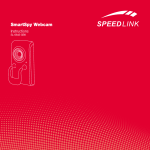
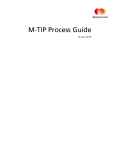
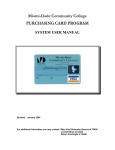

![FRONIUS IG US [42,0410,1089]](http://vs1.manualzilla.com/store/data/005774043_1-689bd6c2a055f0ab88c64924d7fd22c0-150x150.png)
